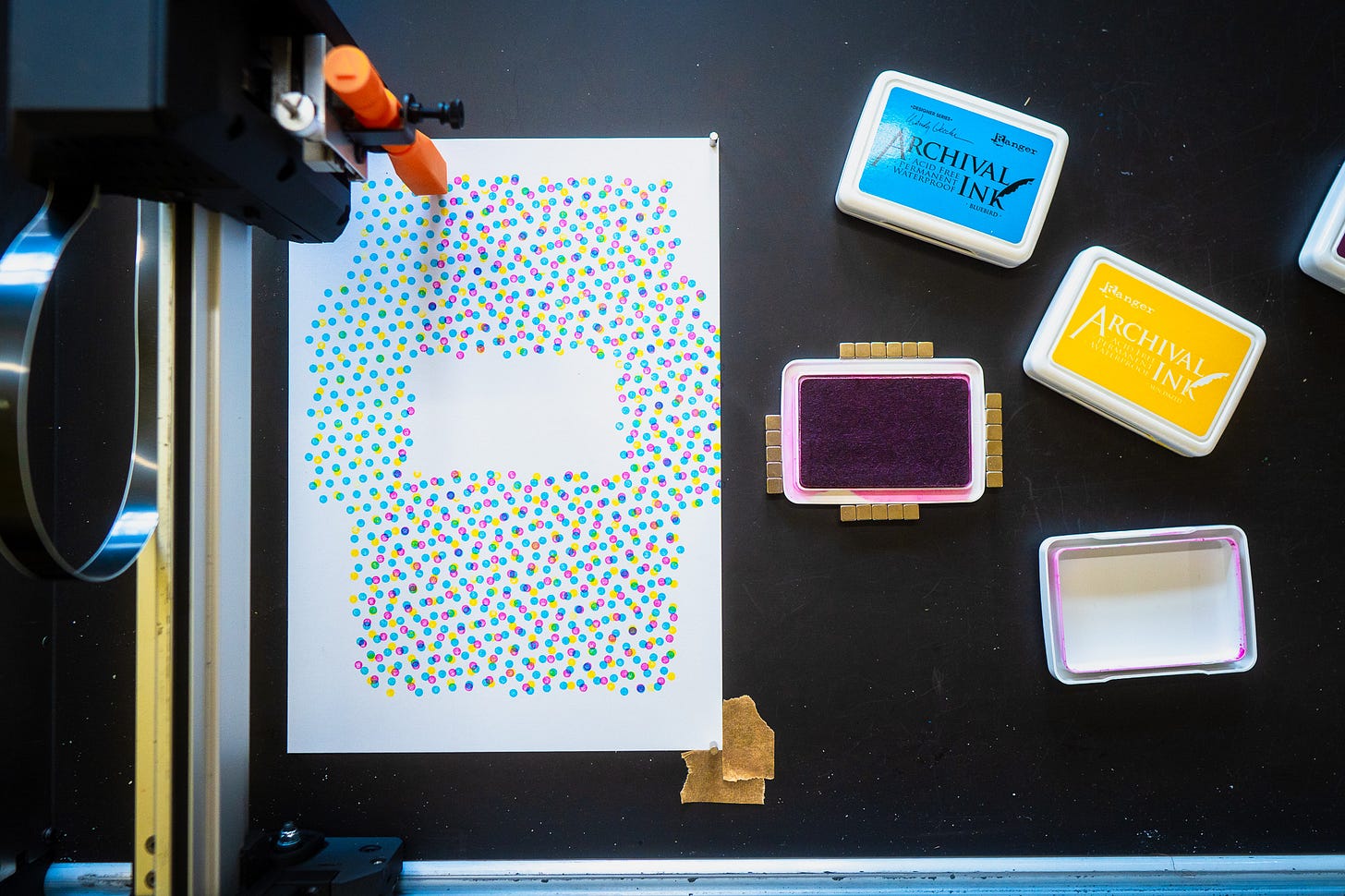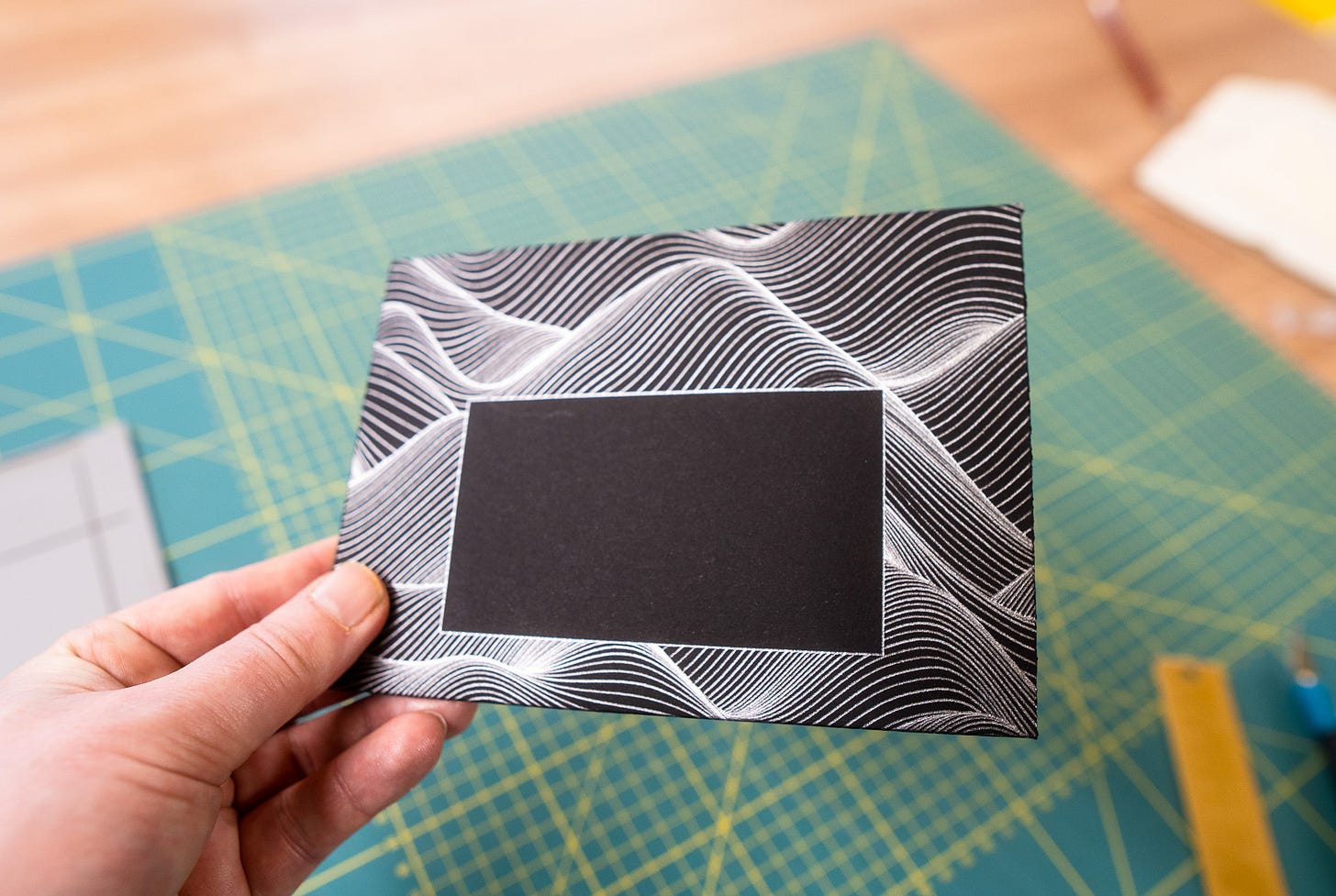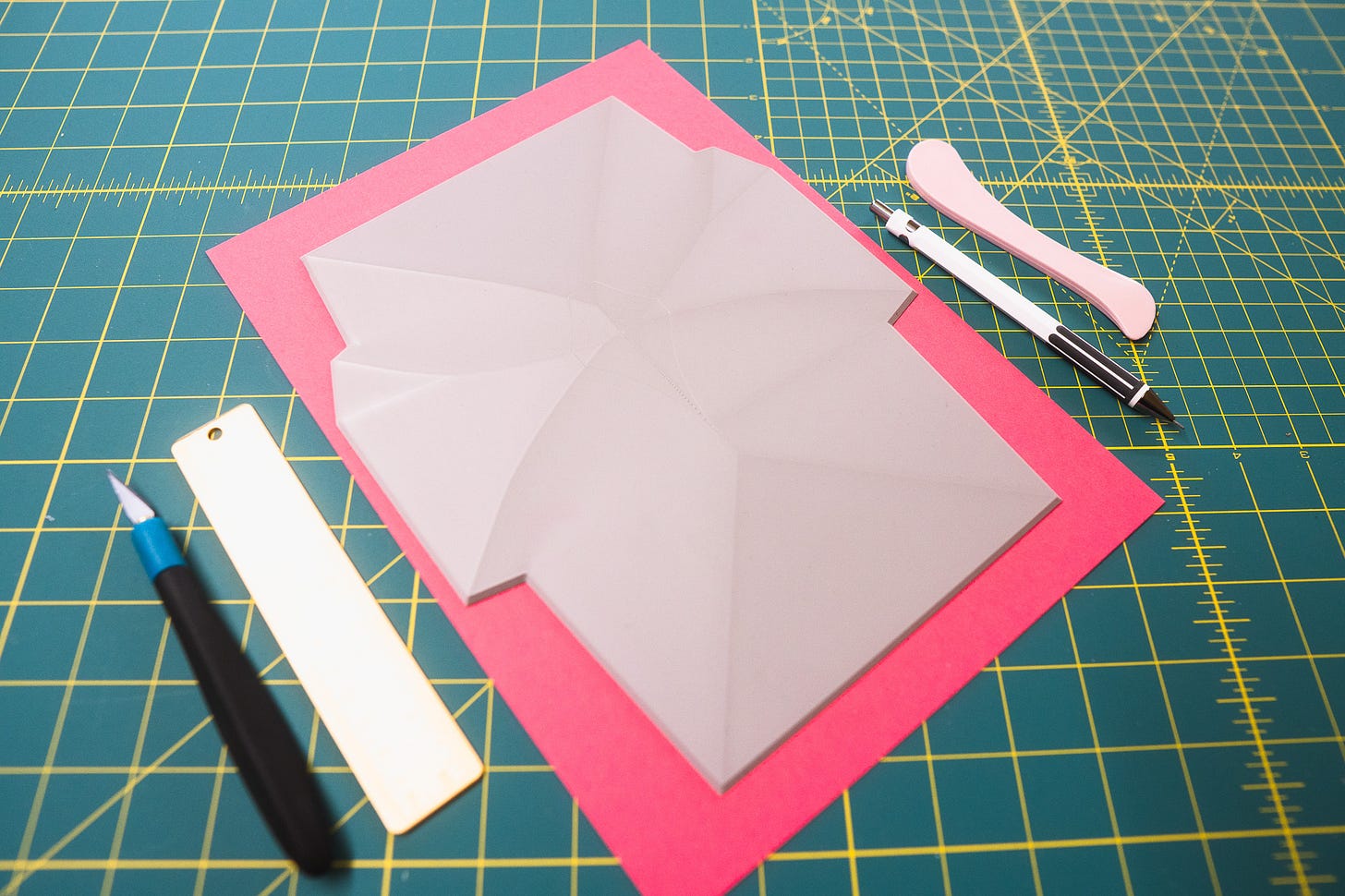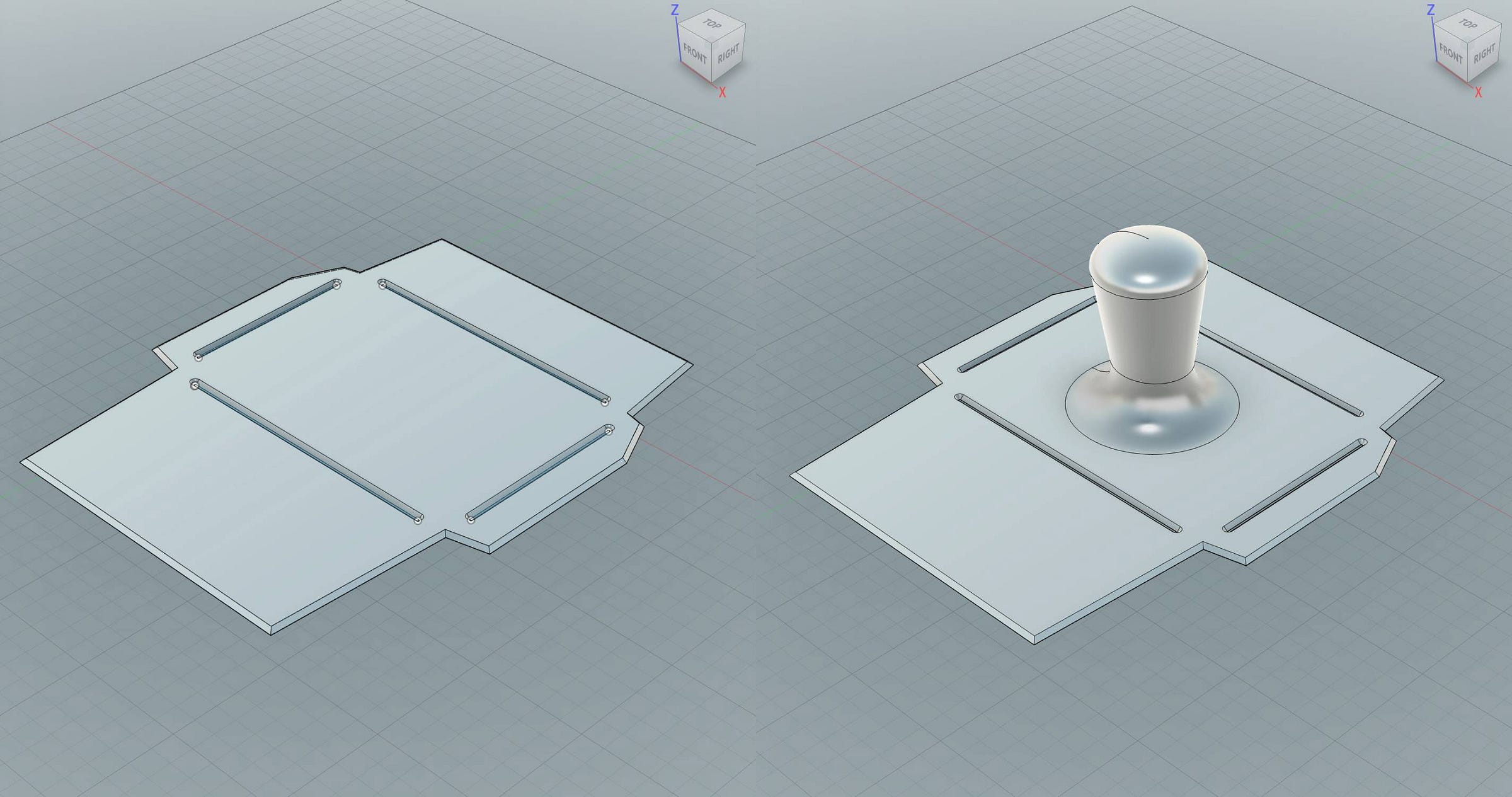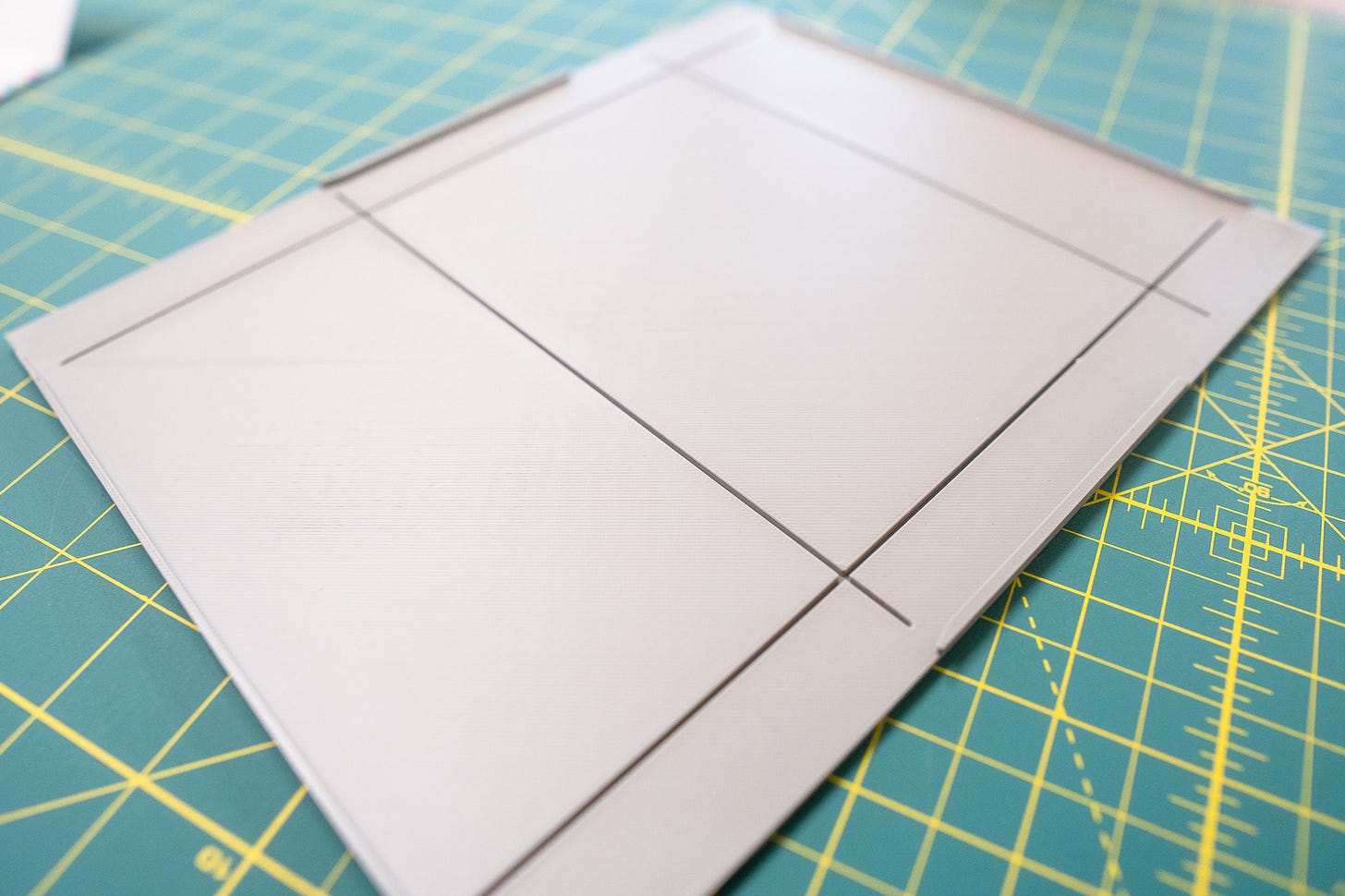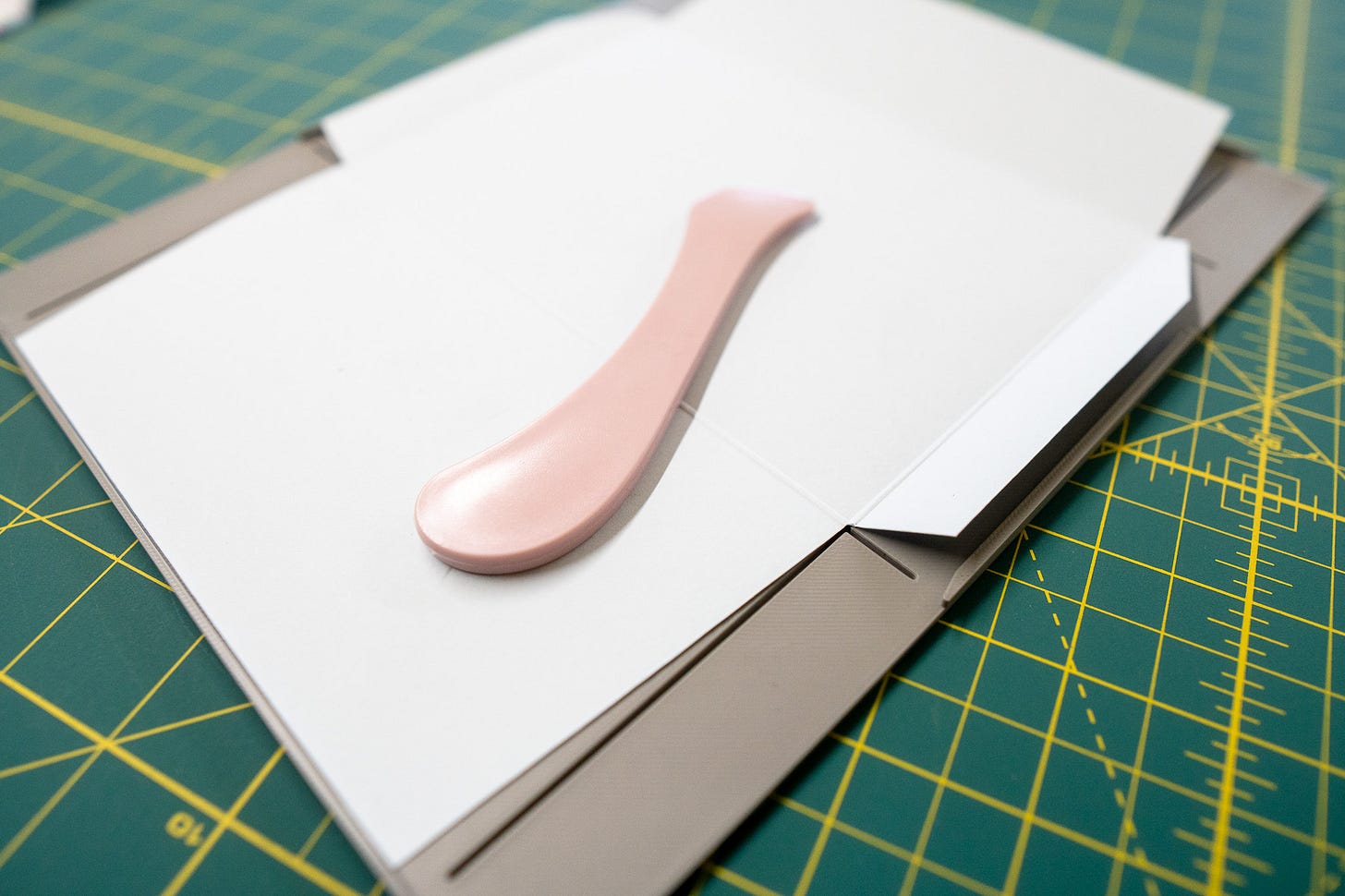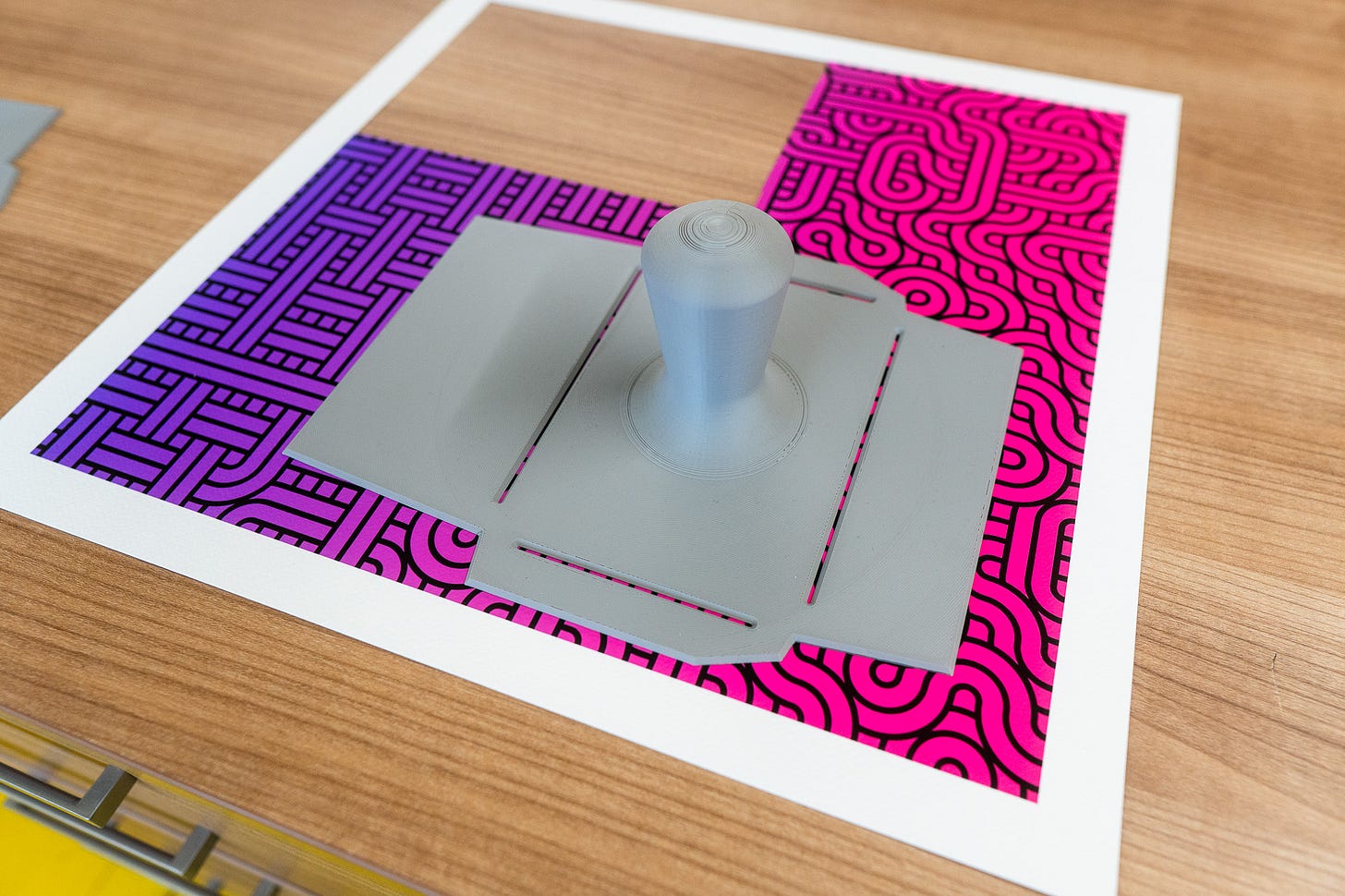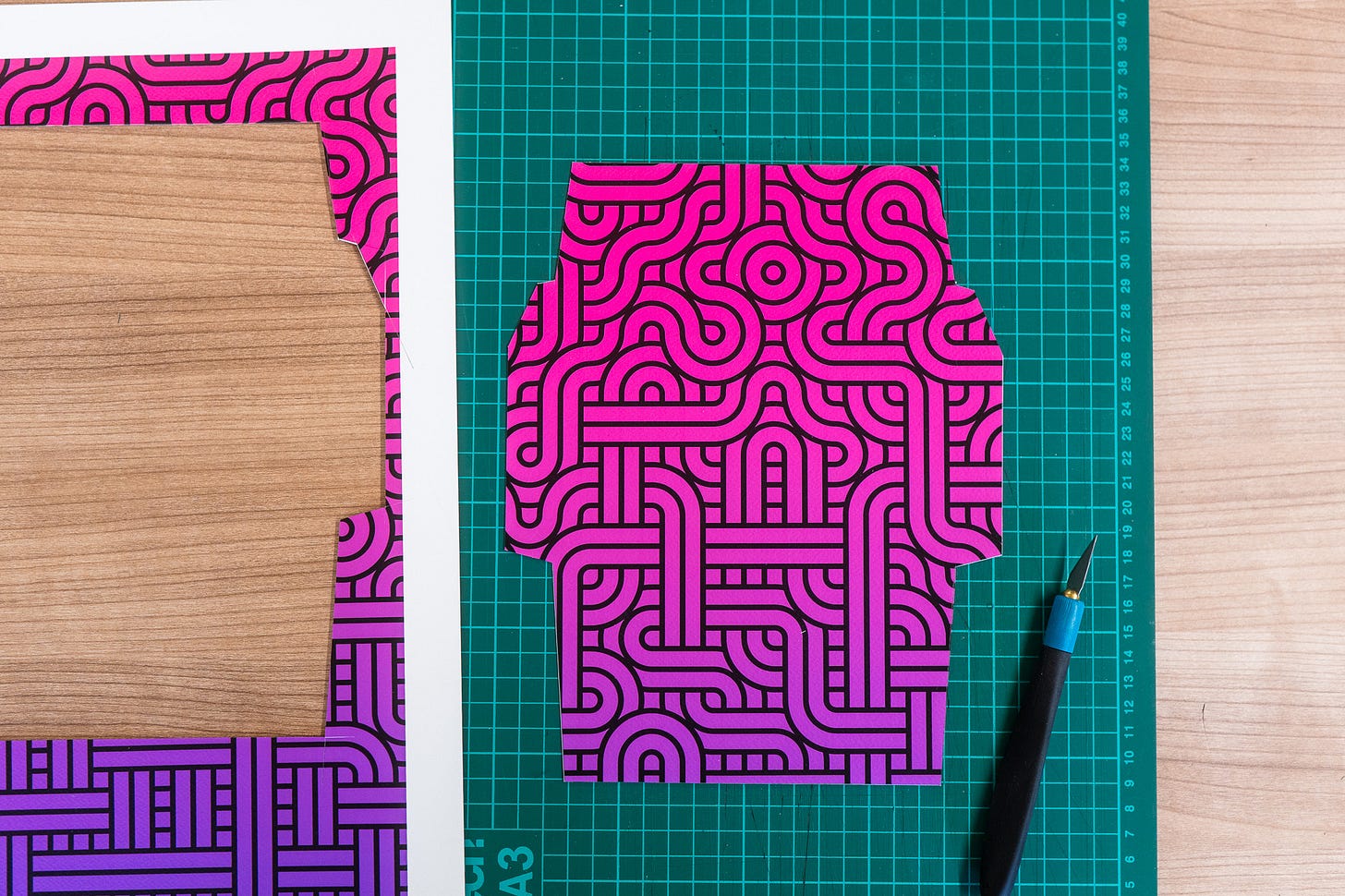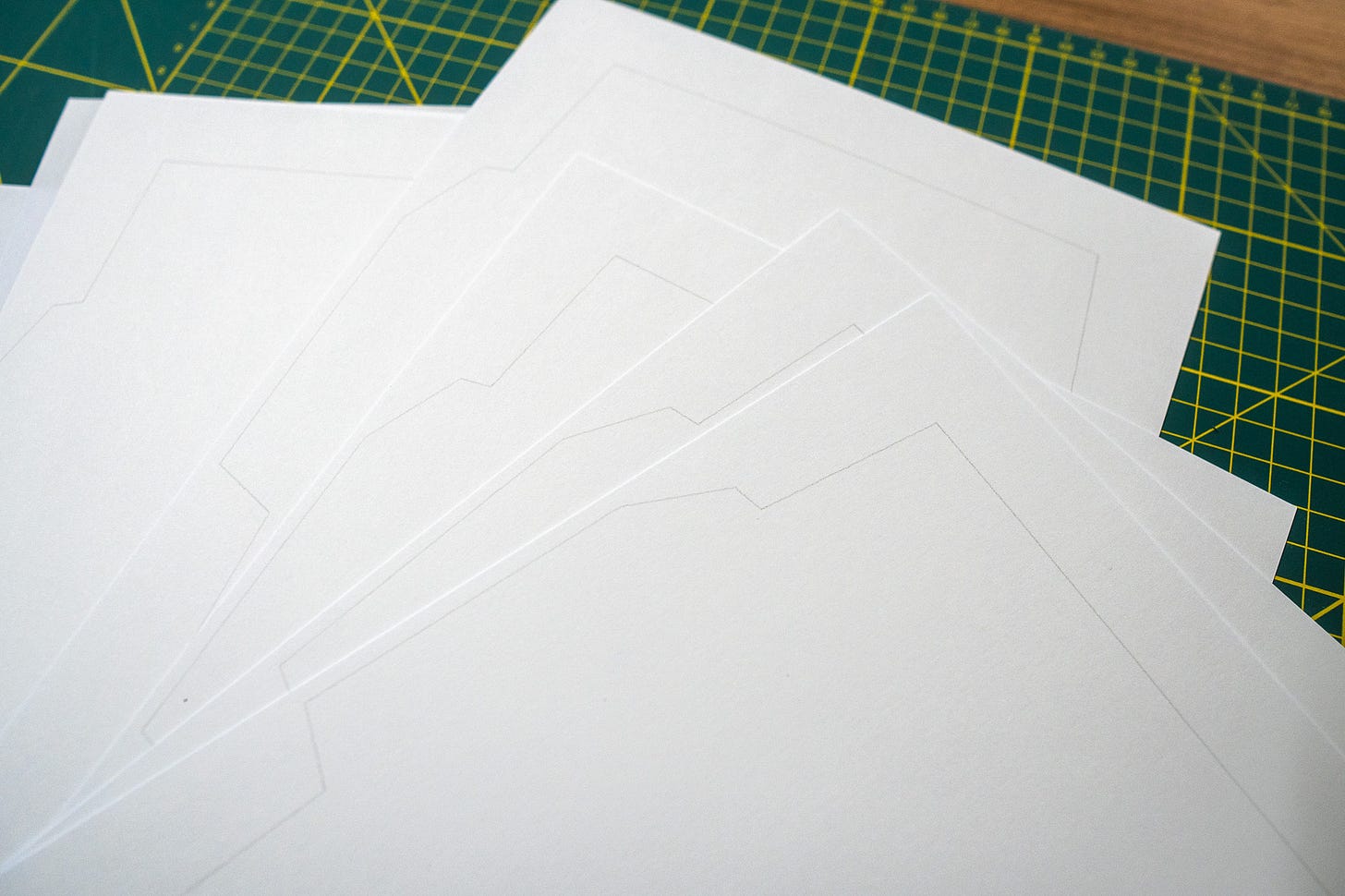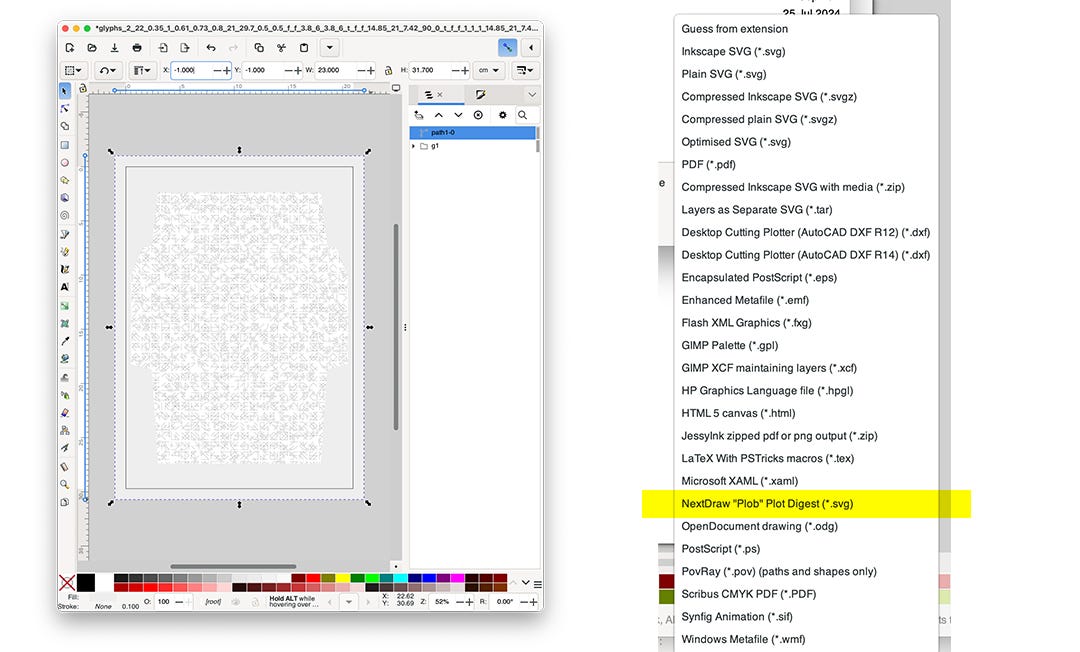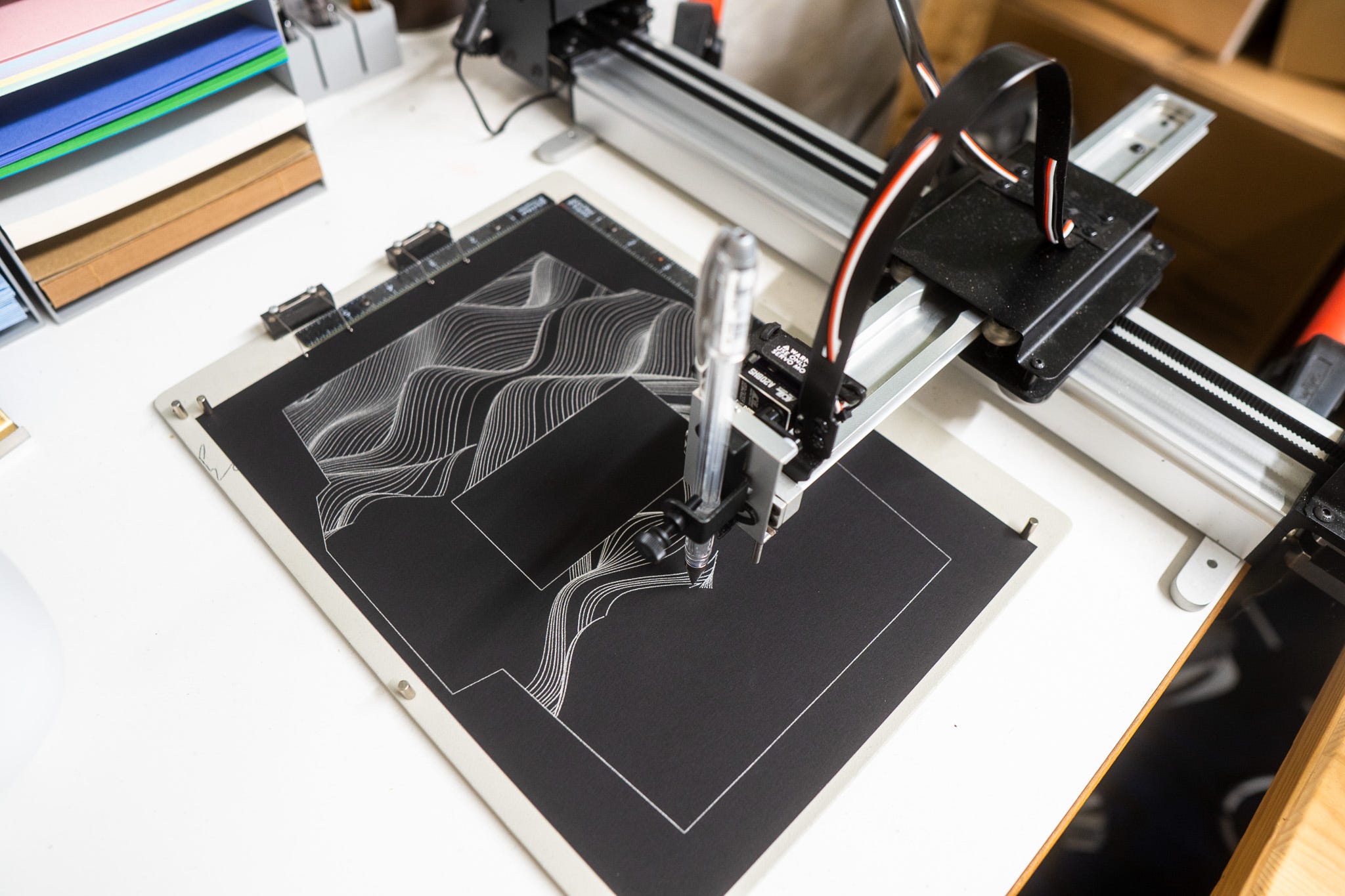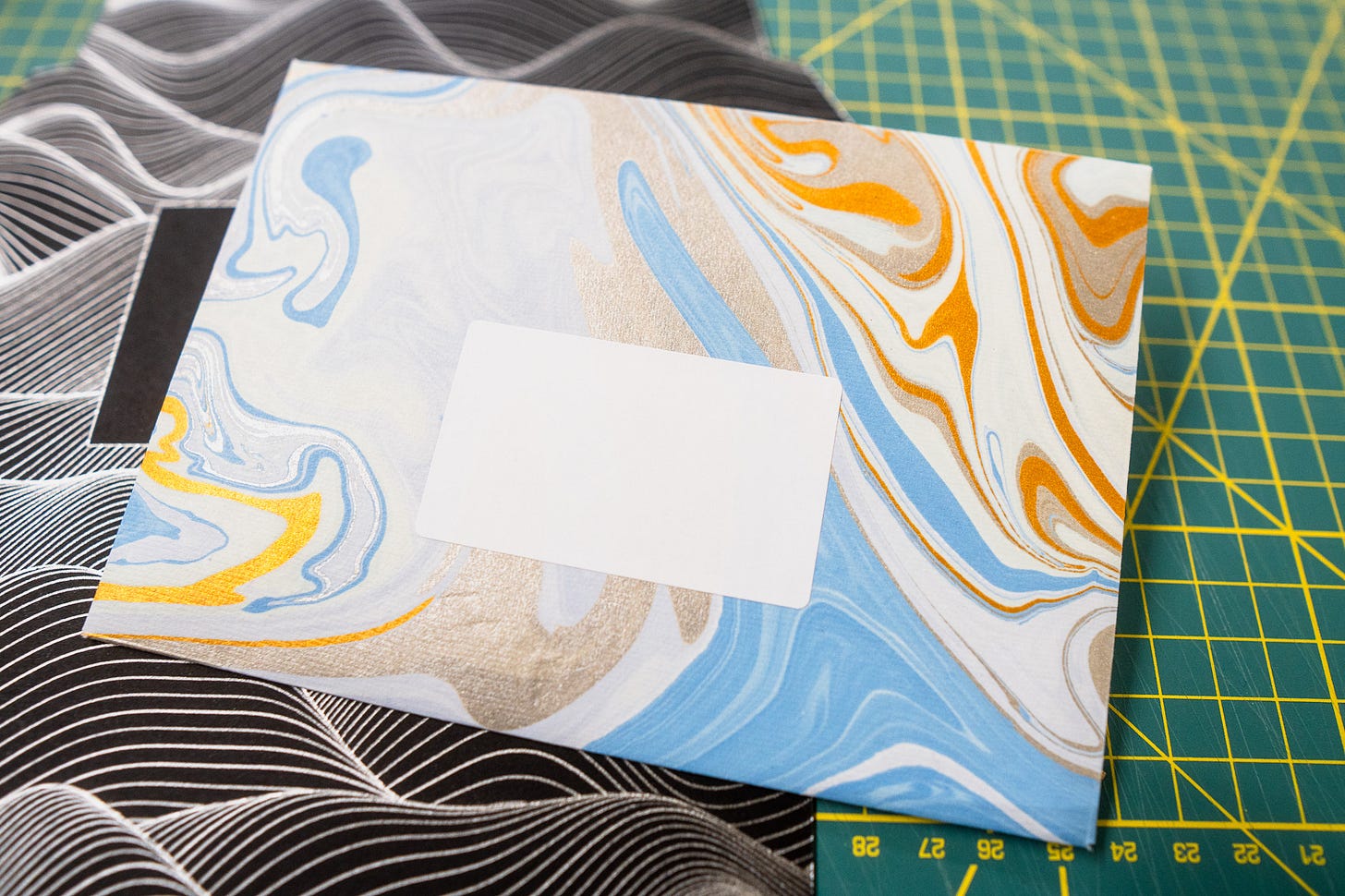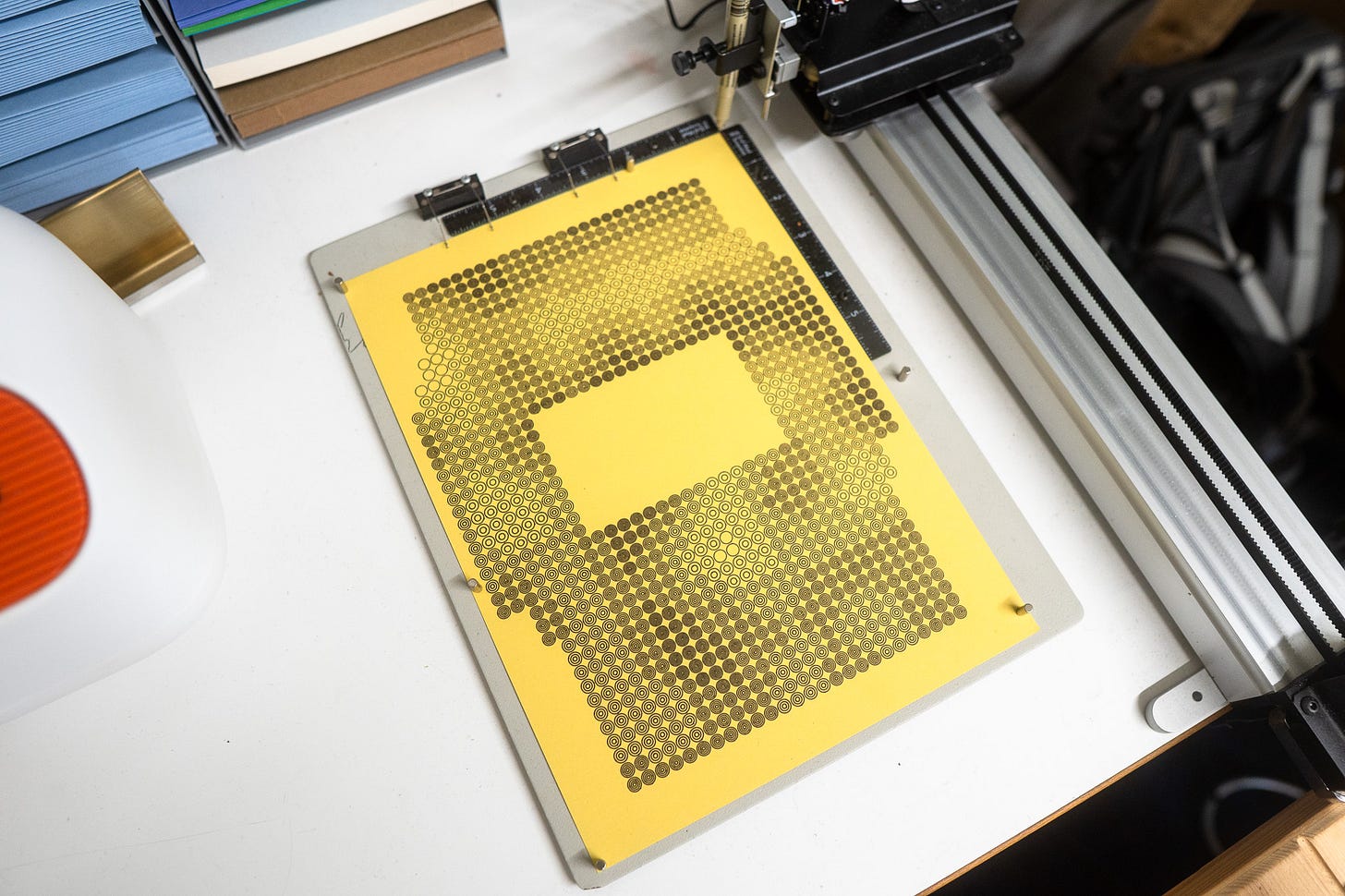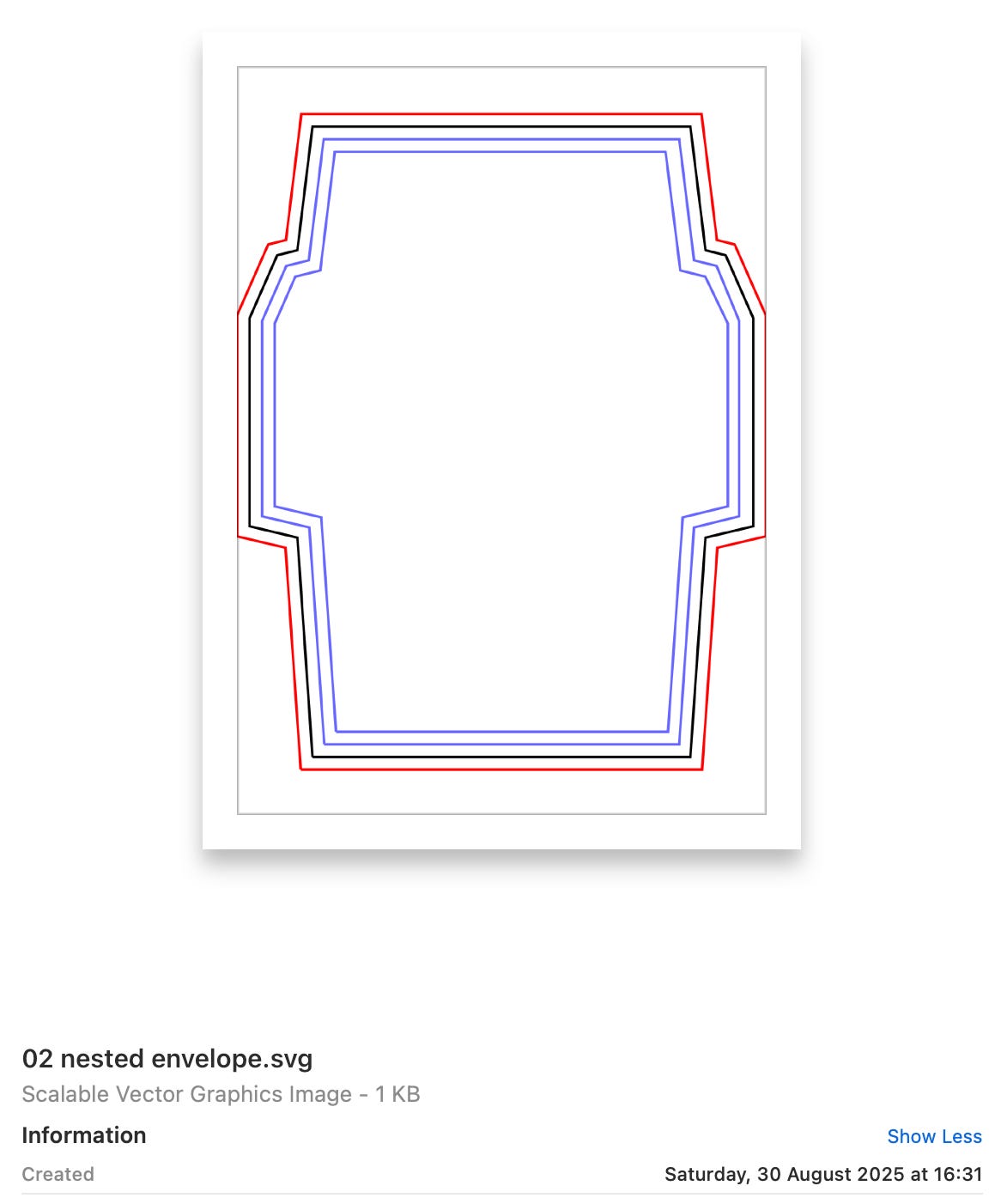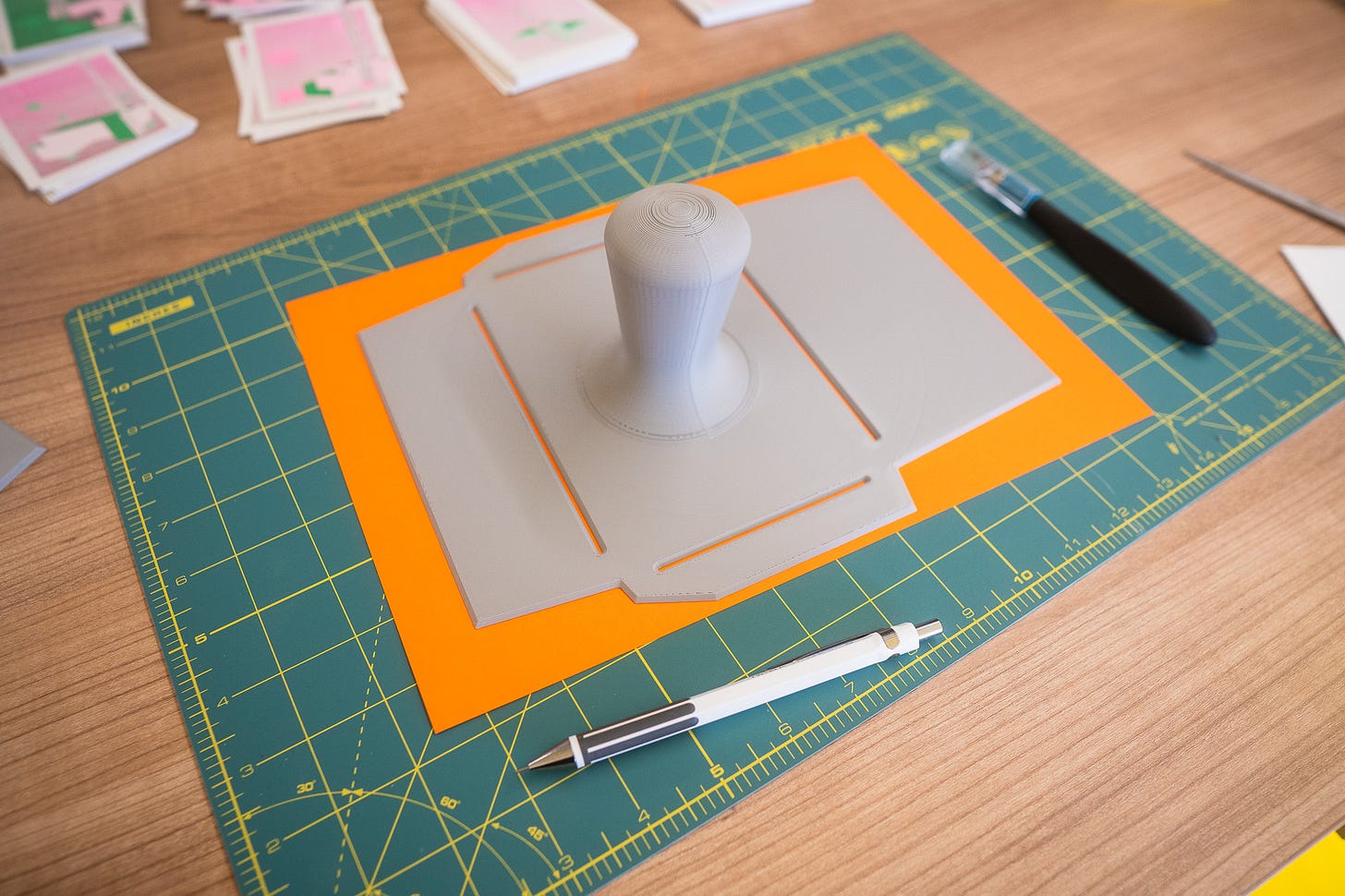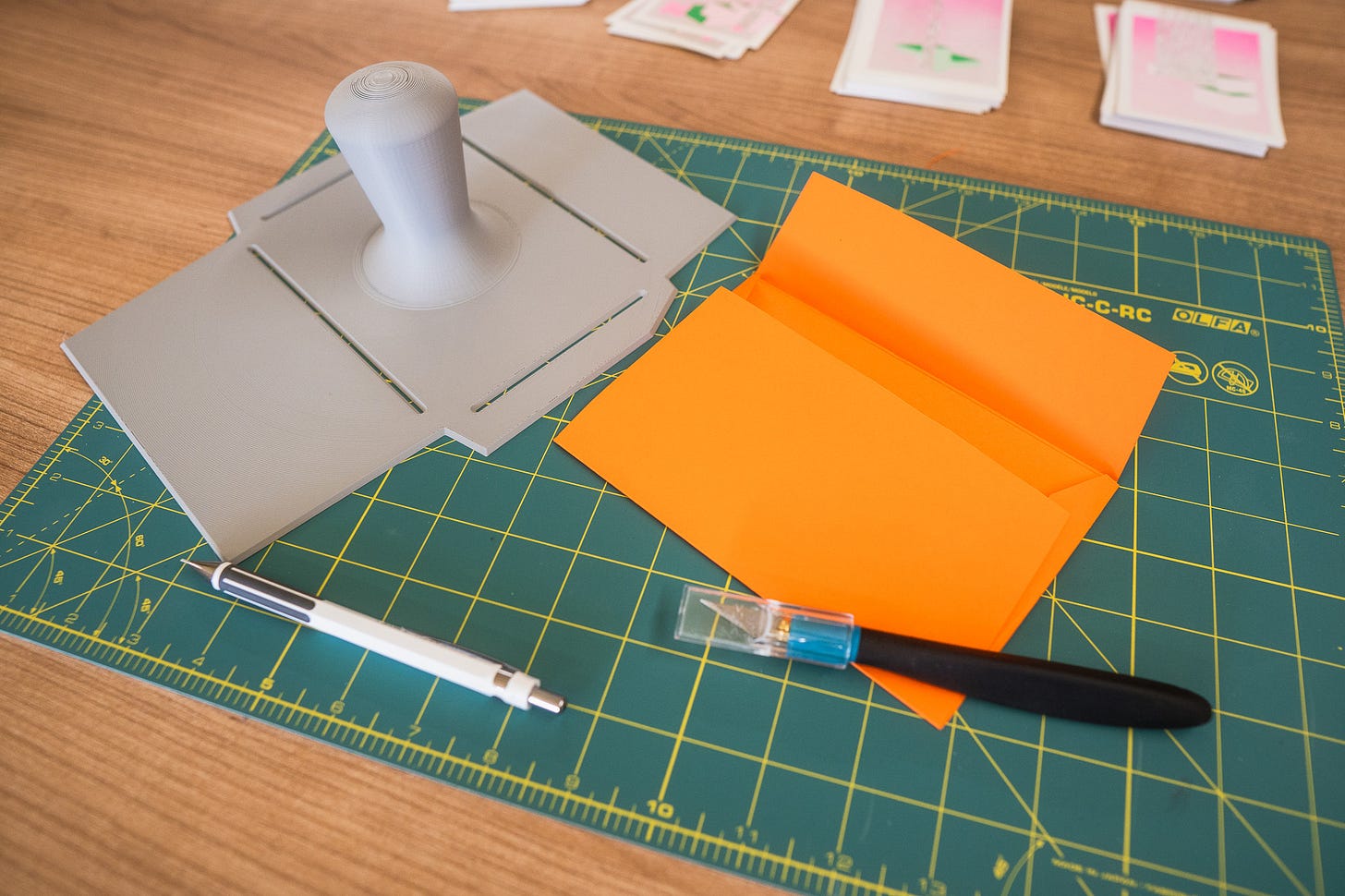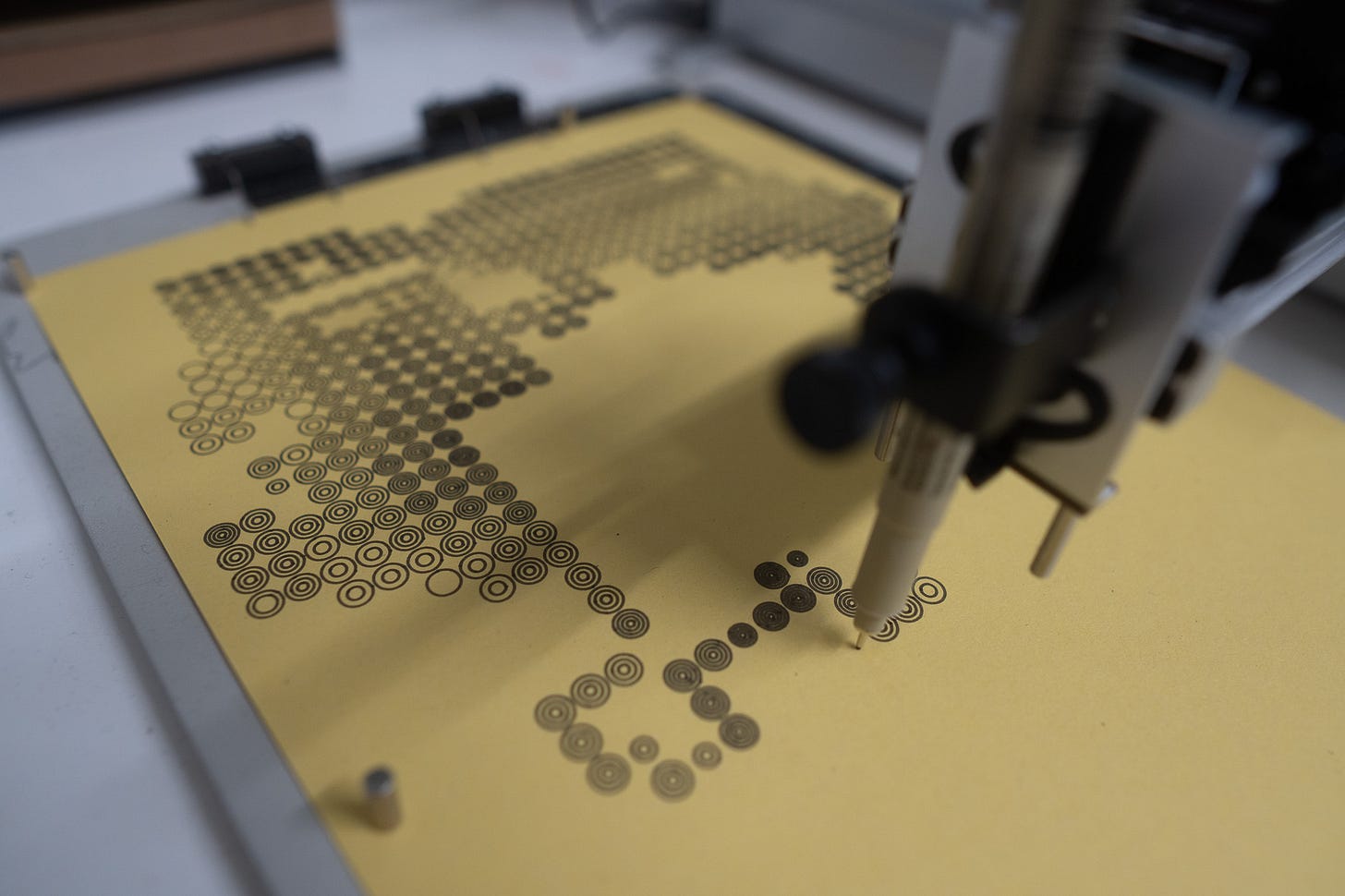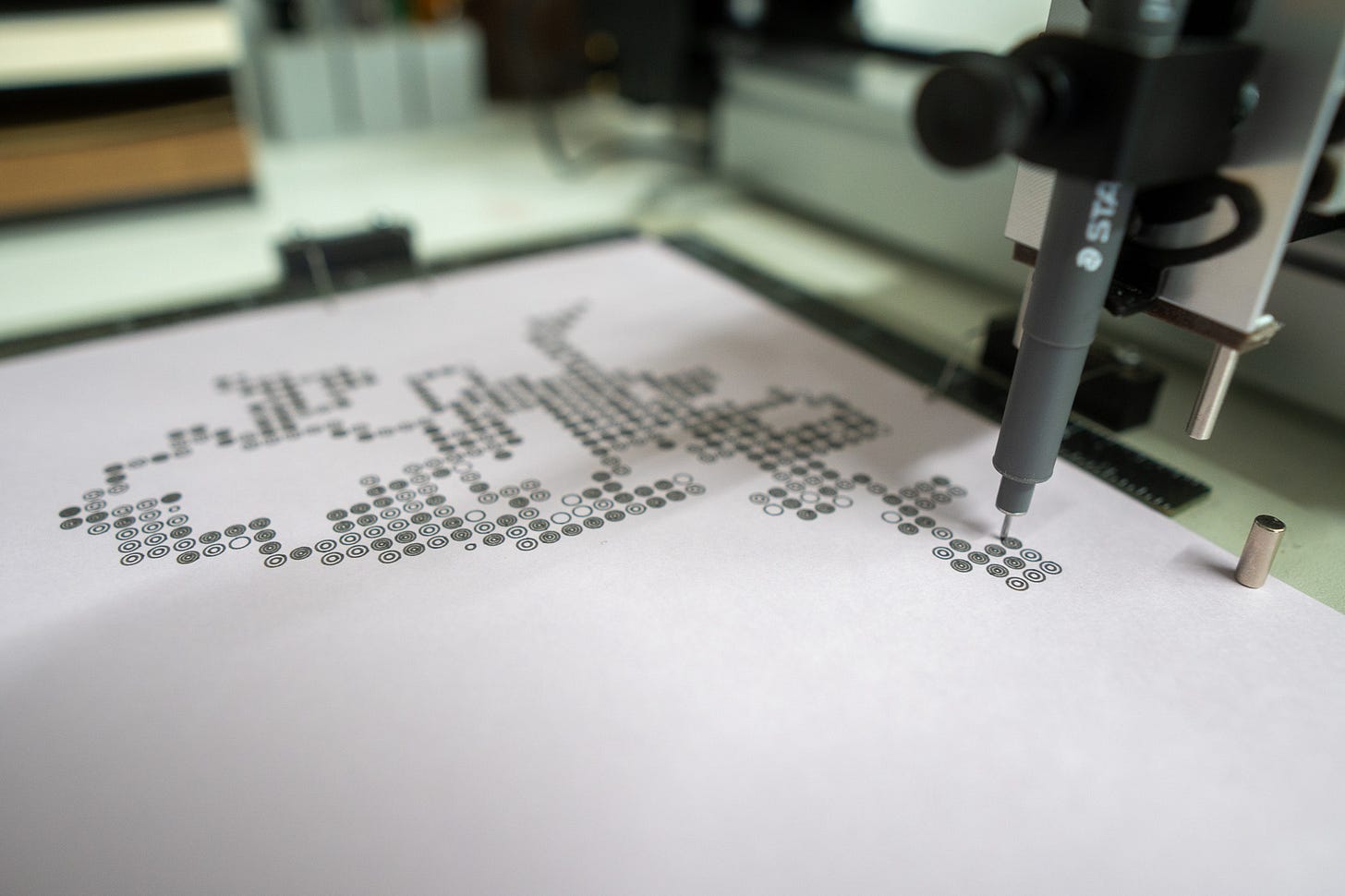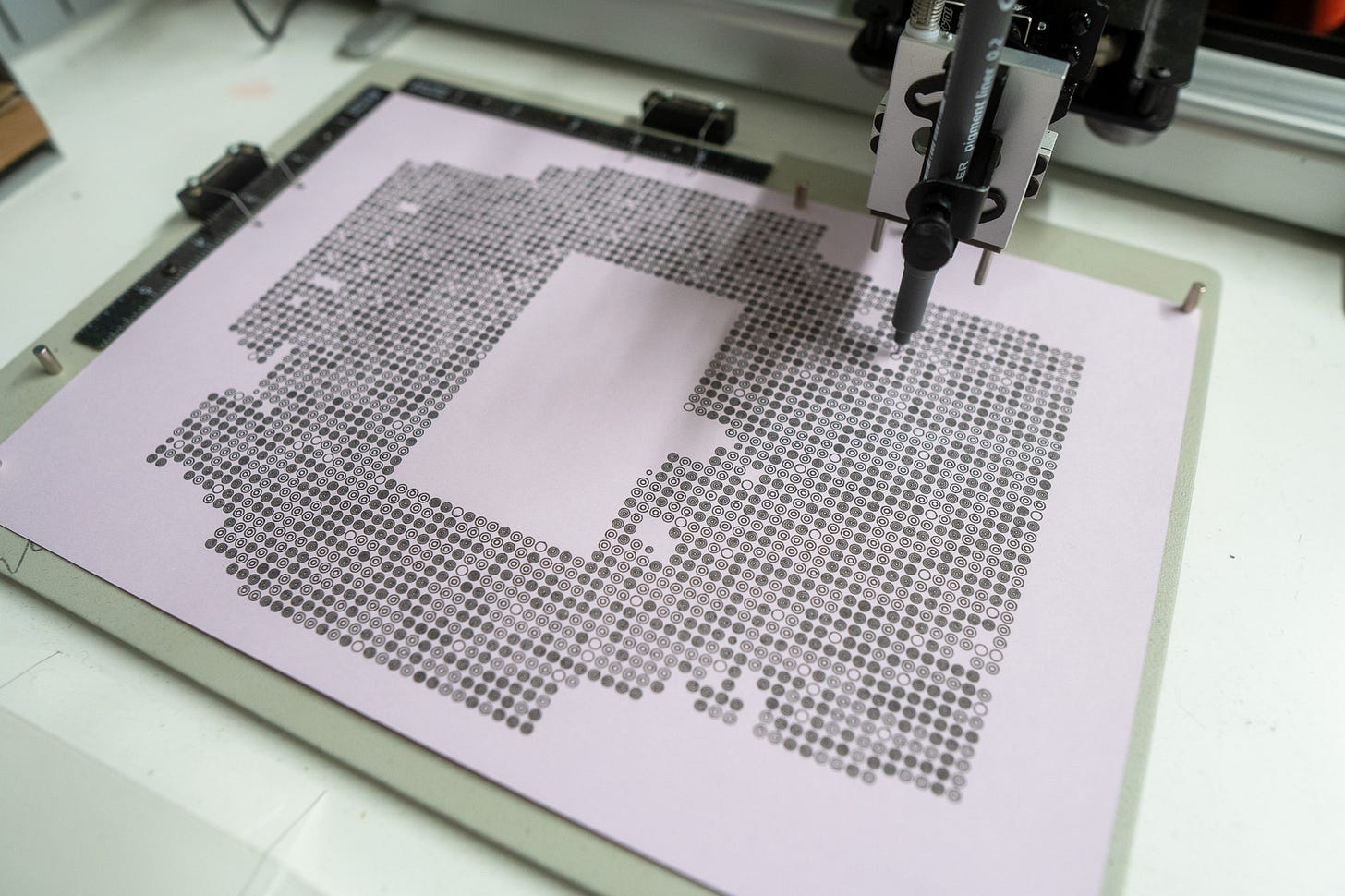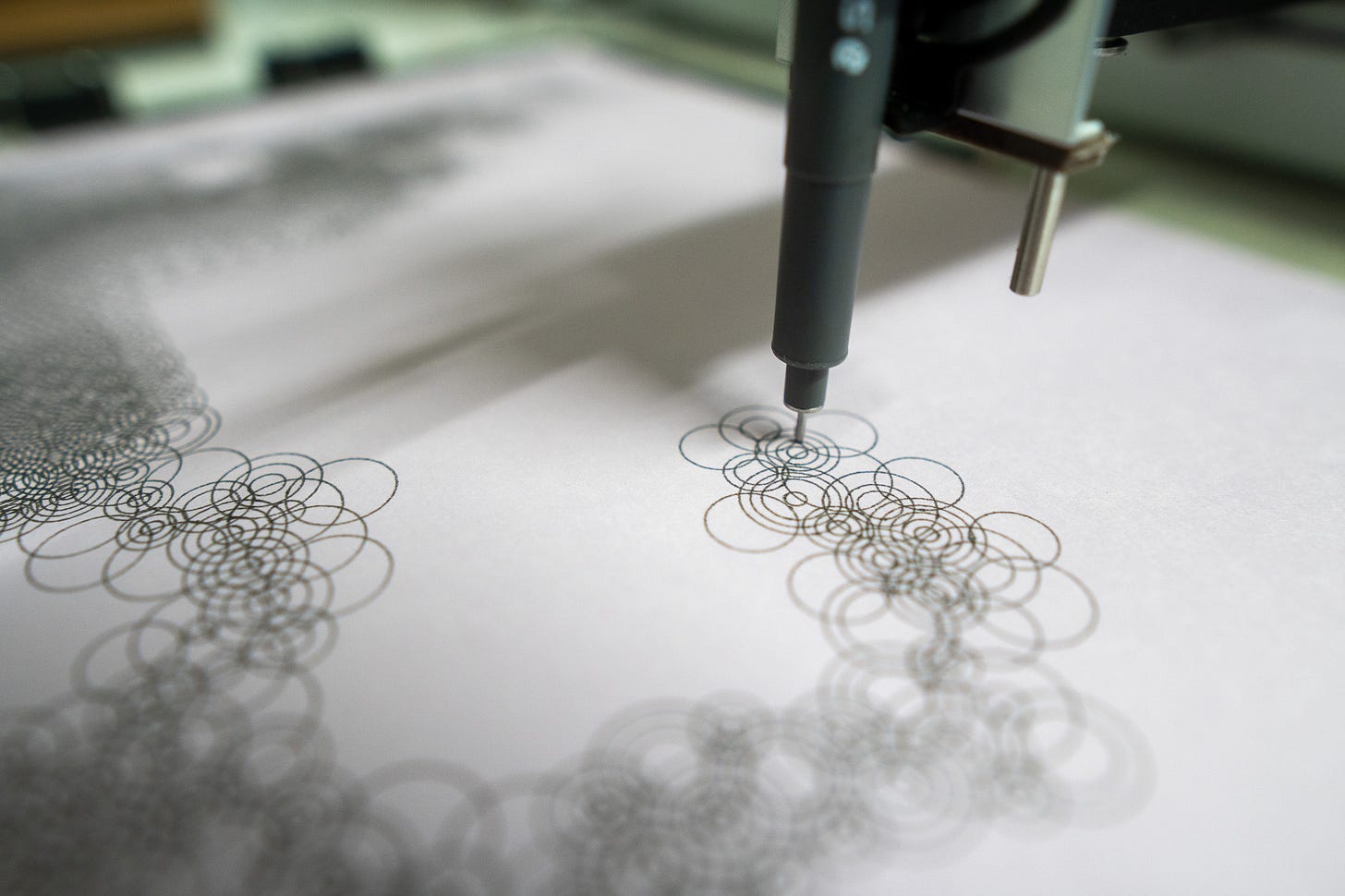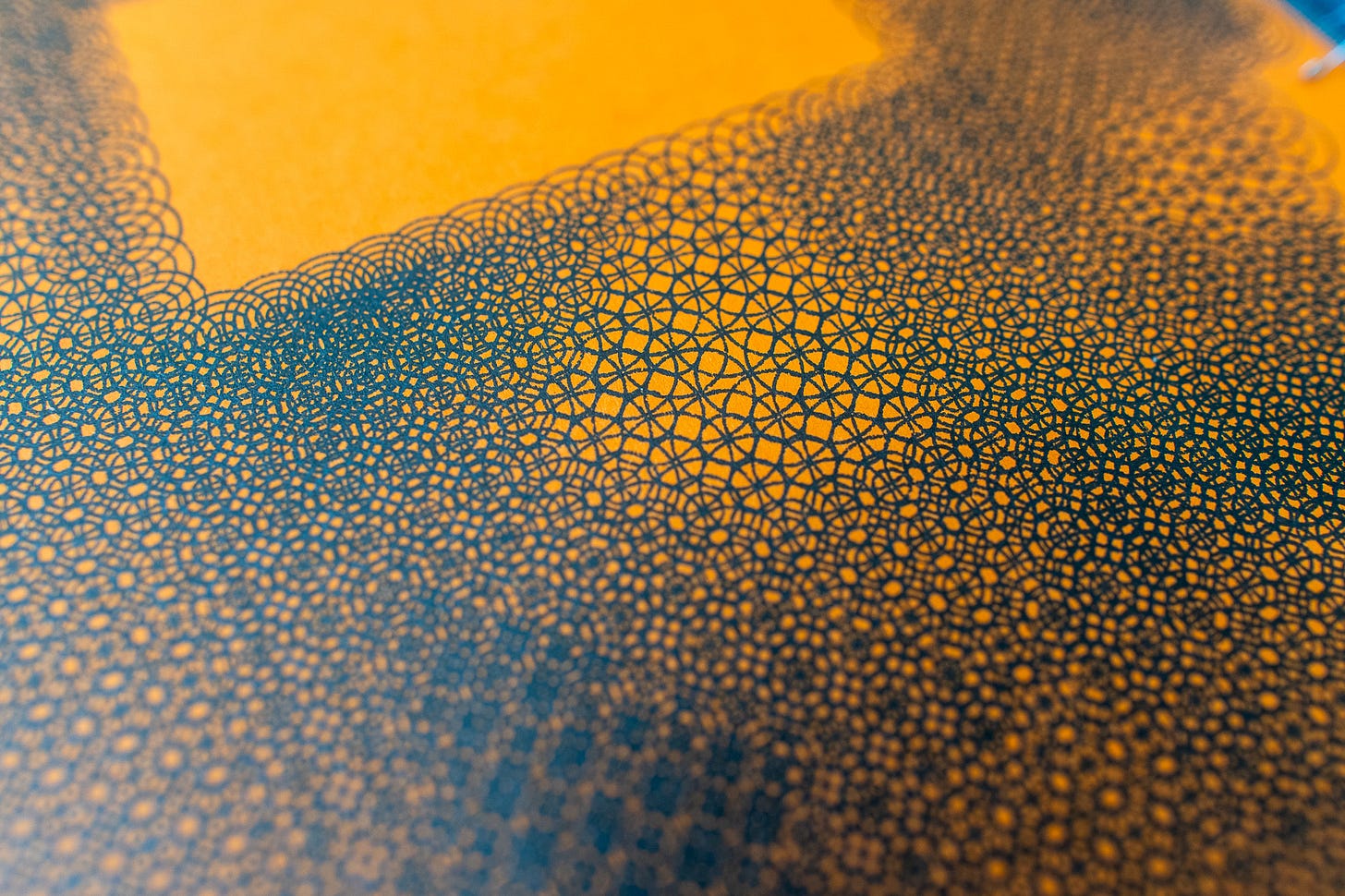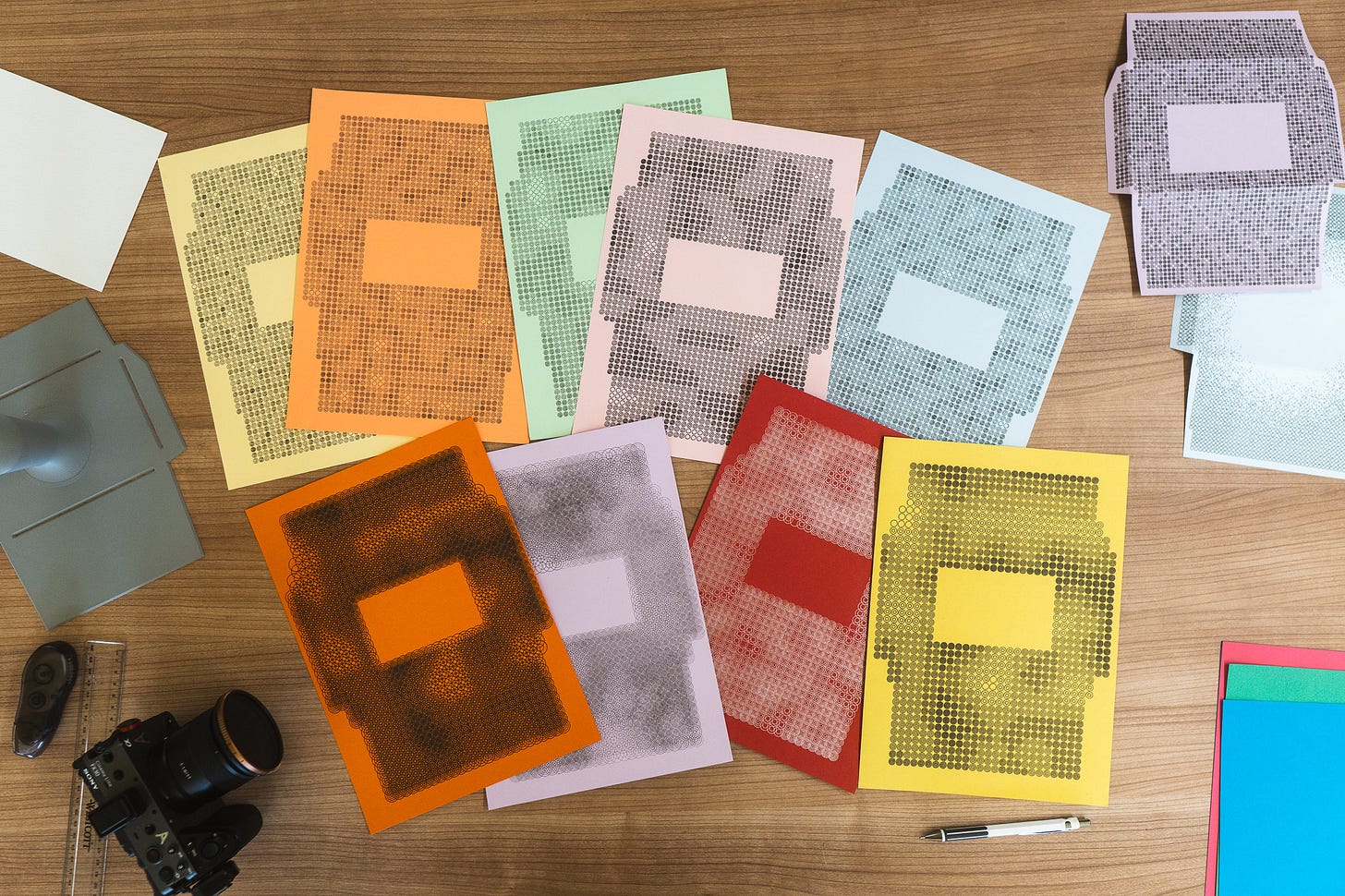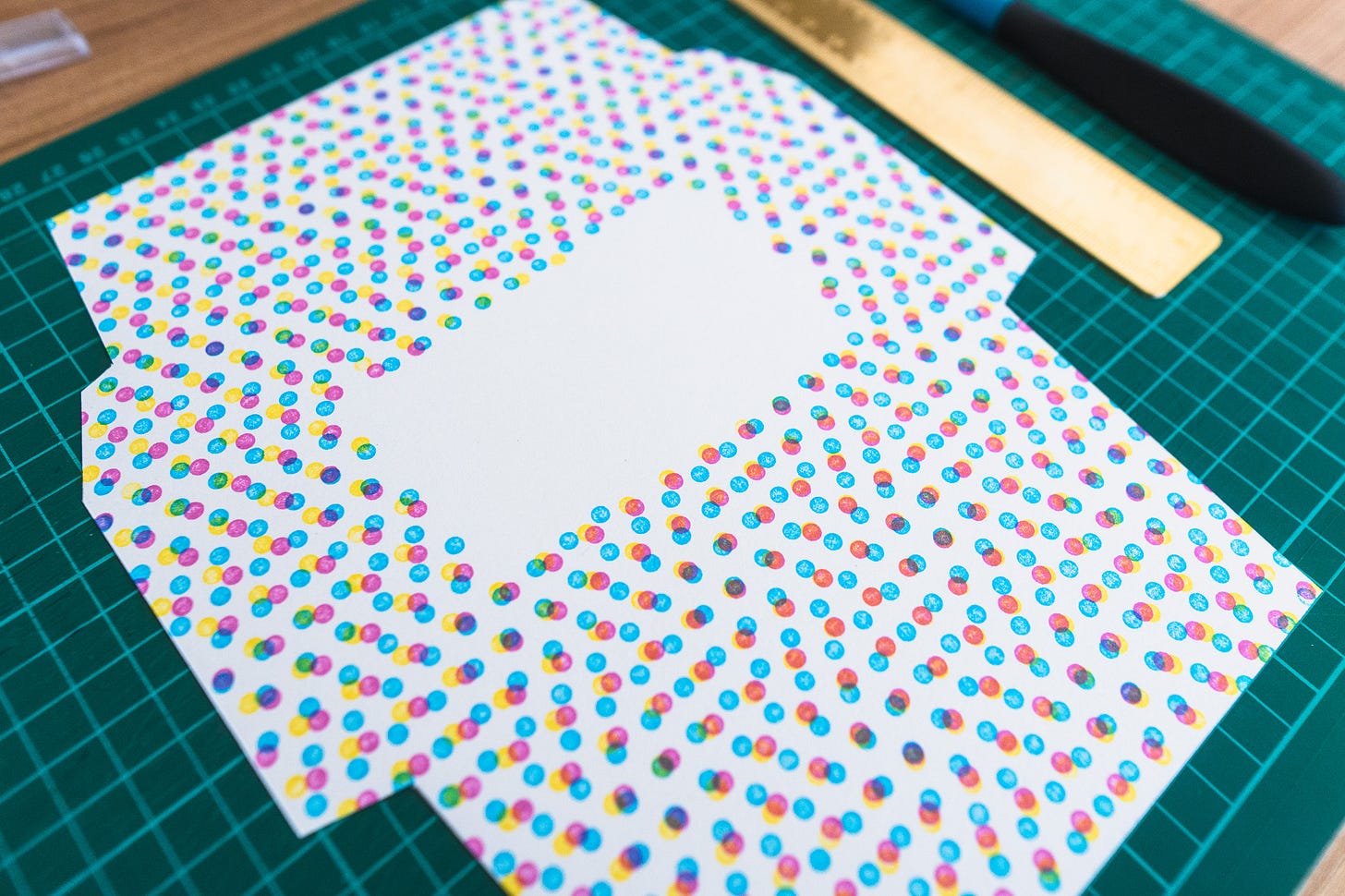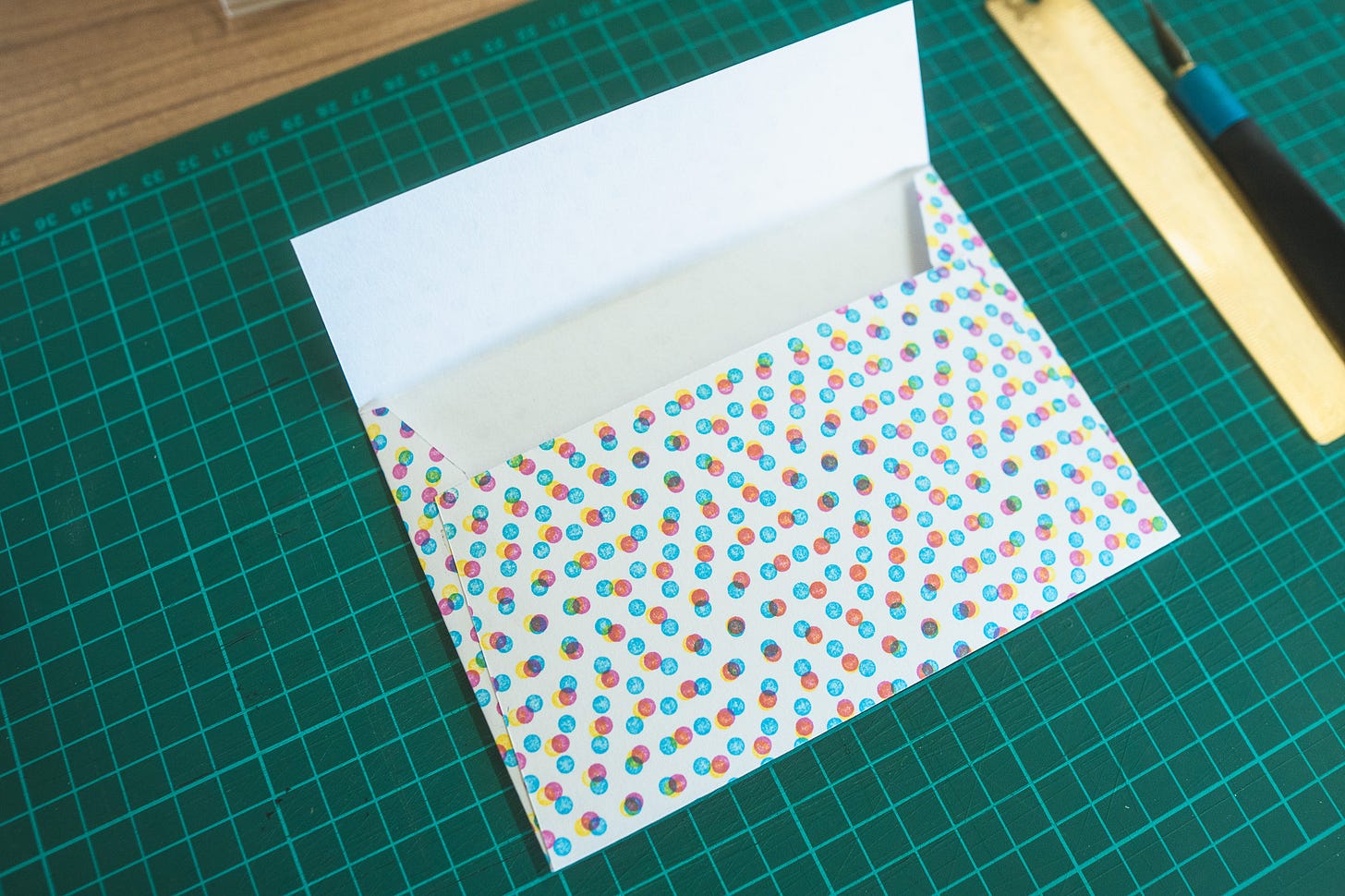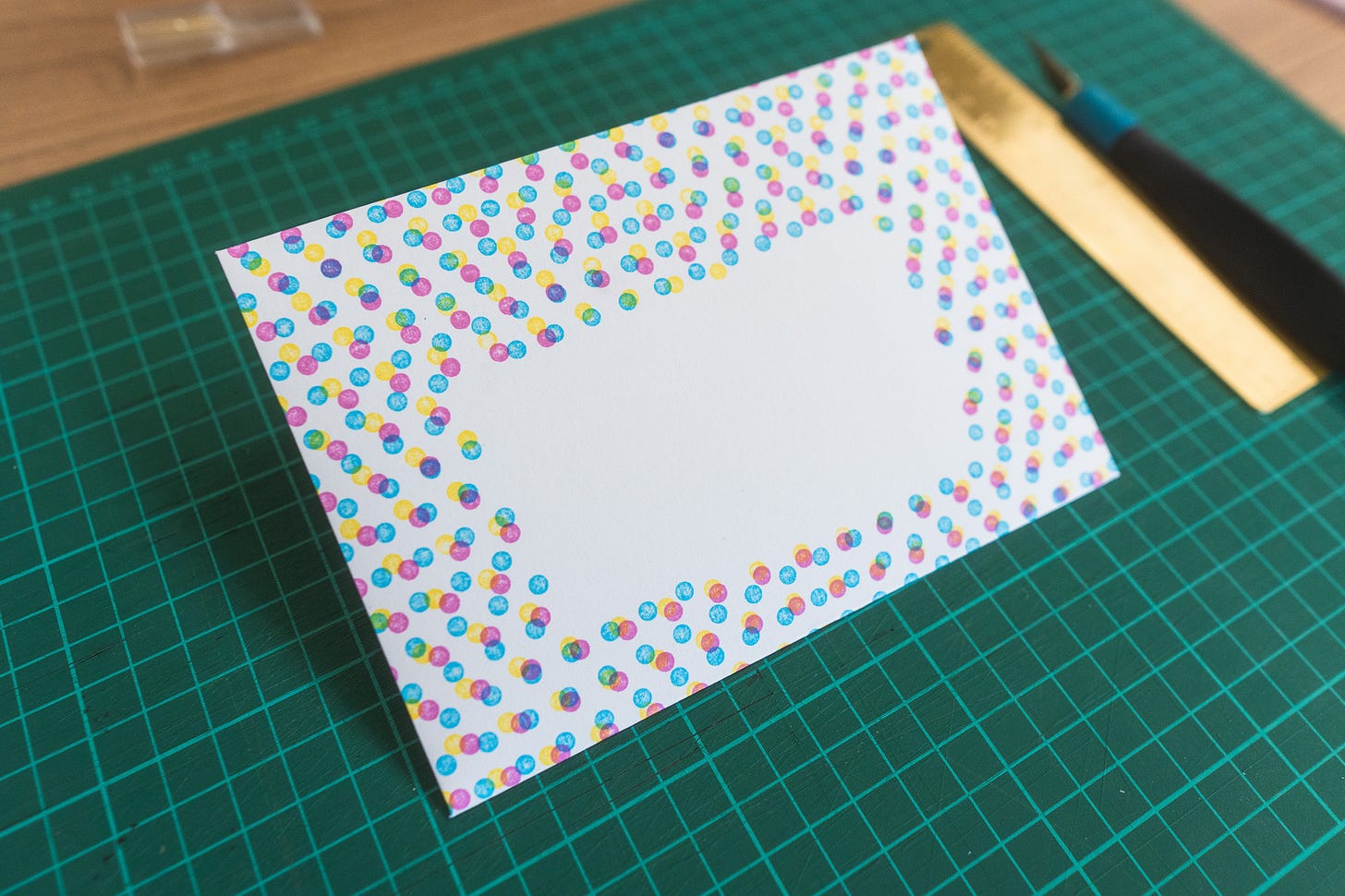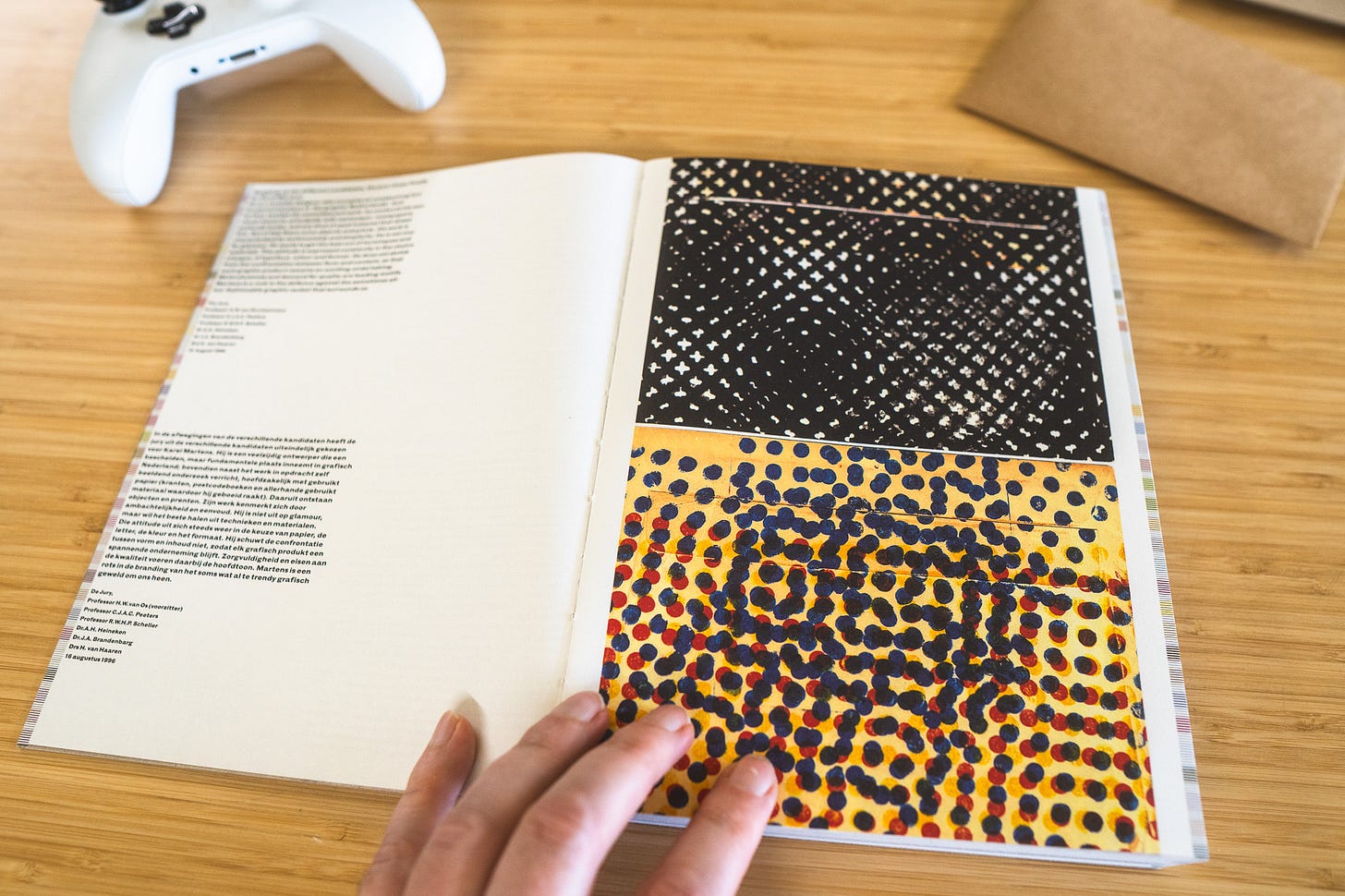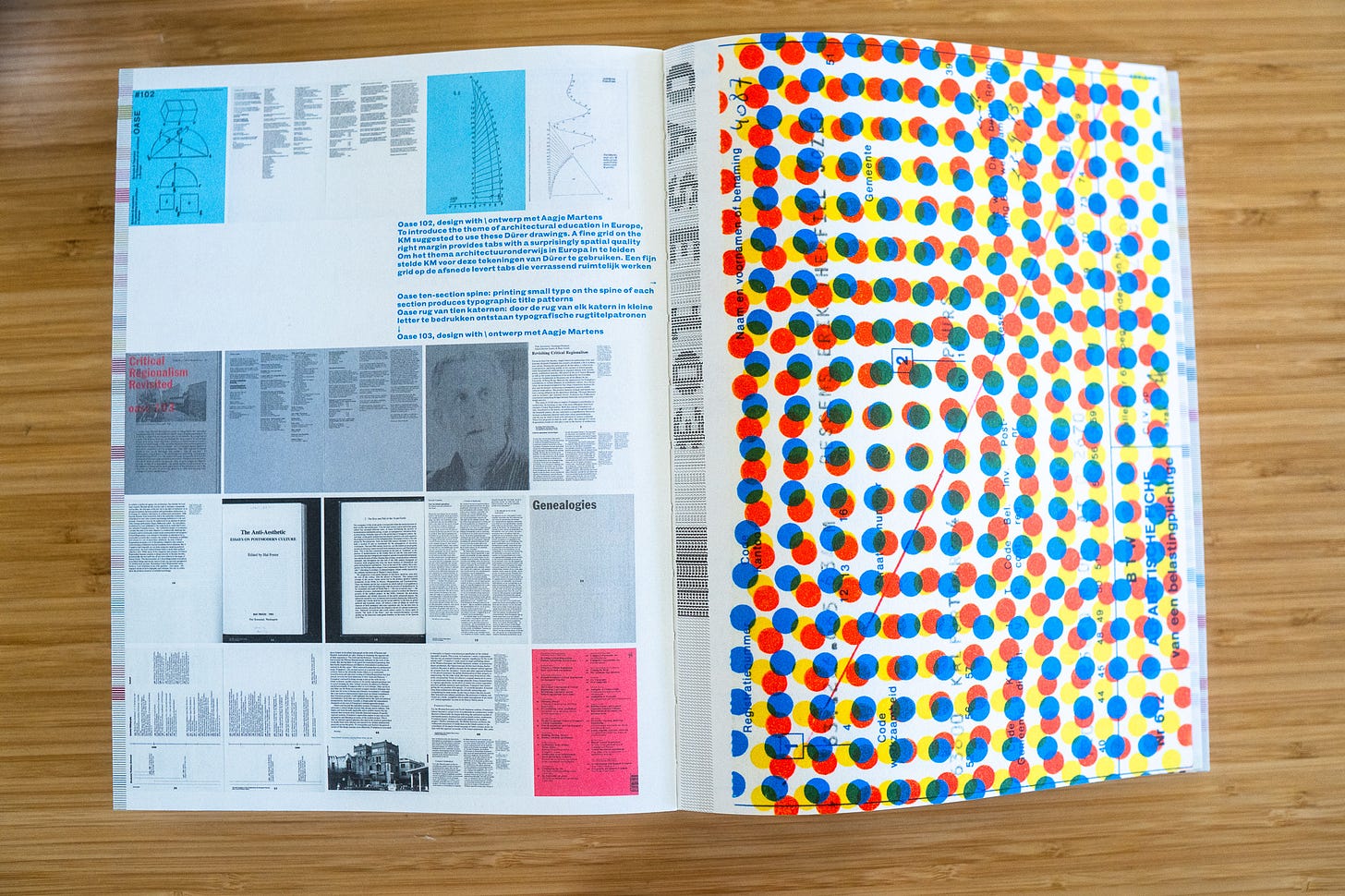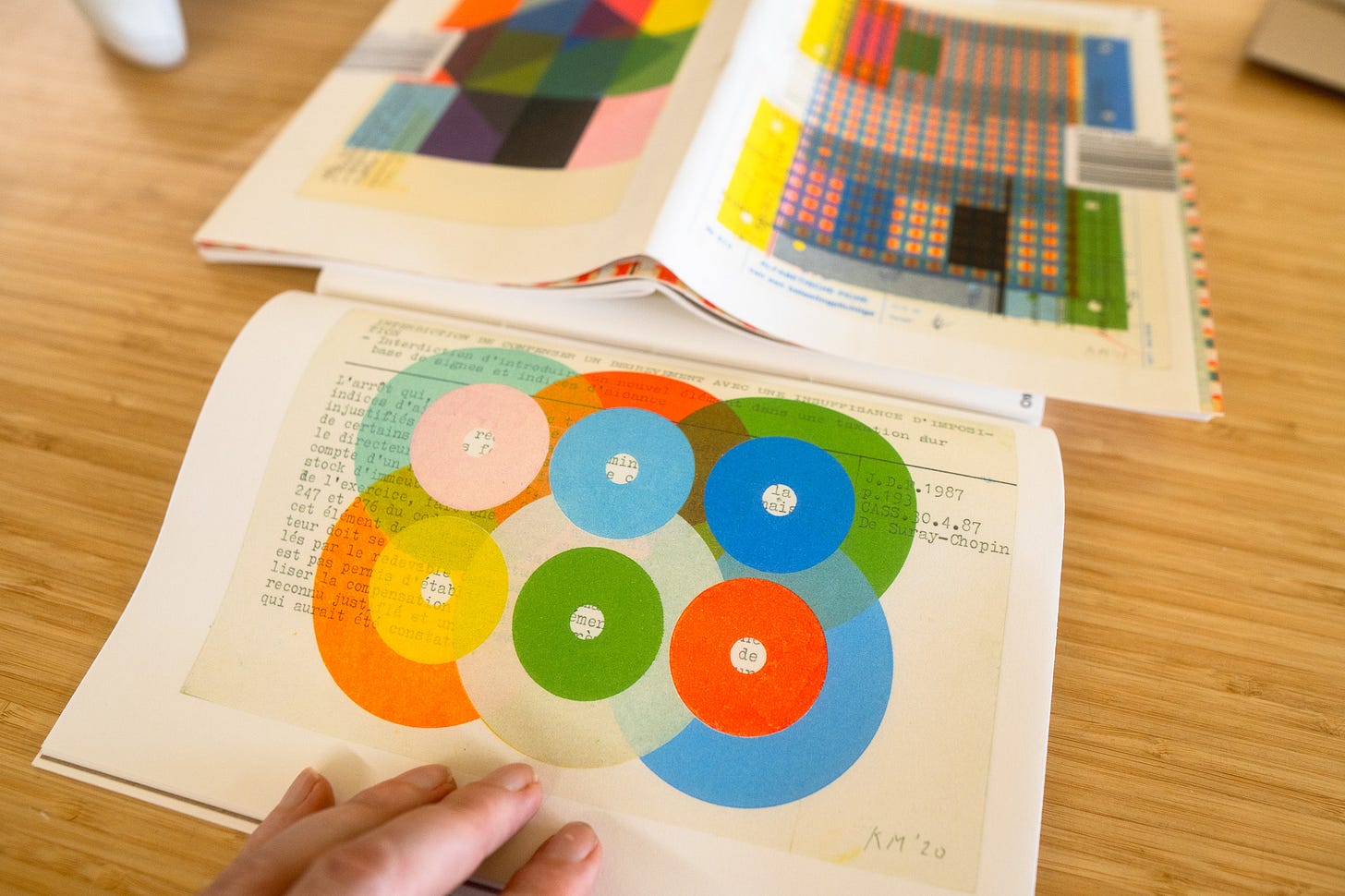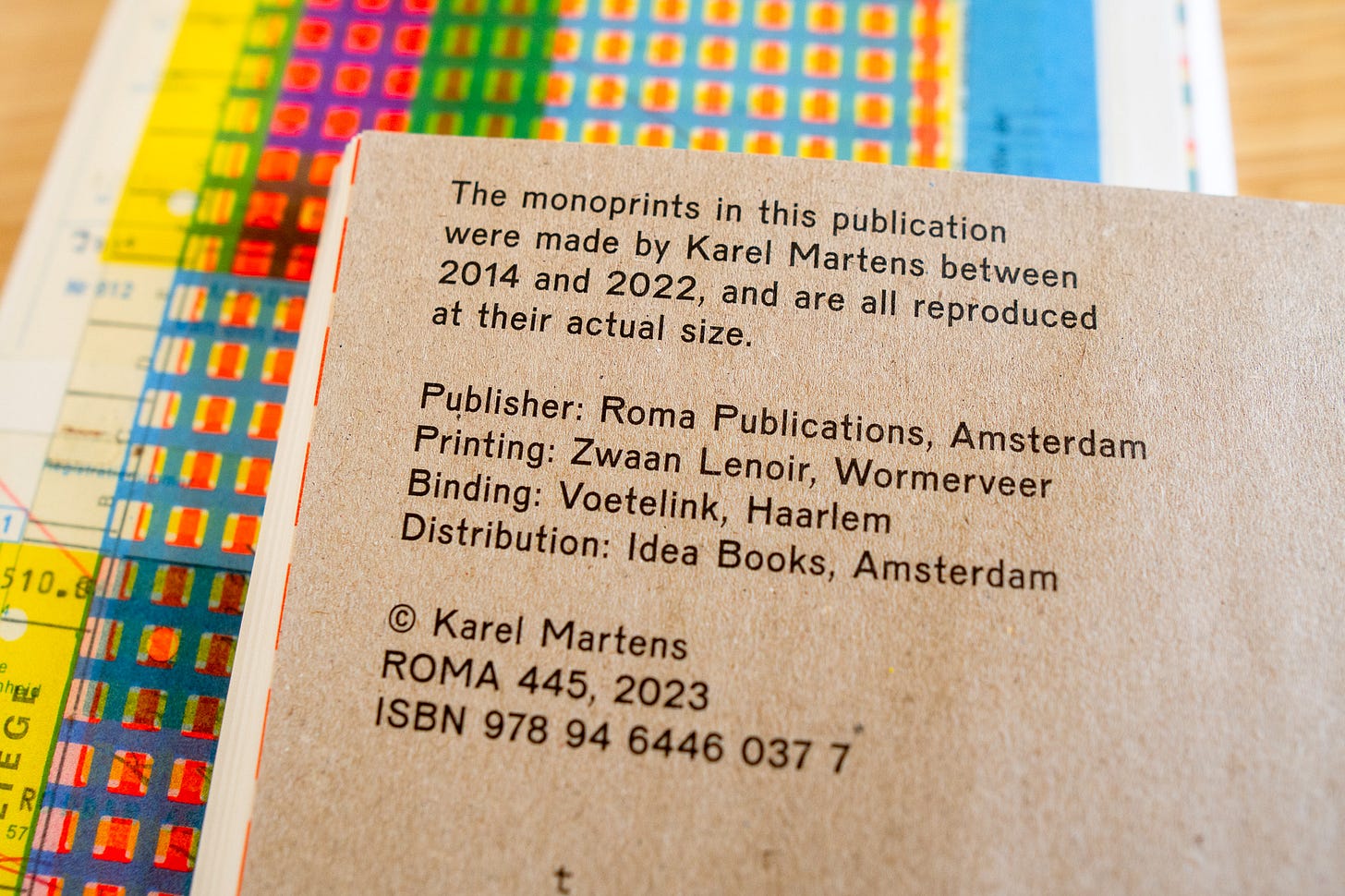📙 #069 - I bring you the gift of: Envelopes
I come bearing tools, files, algorithms, inspiration and gifts of an extremely nerdy envelope nature!
Included below;
SVG files for an envelope!
STL 3d files for making an envelope!!
JSON files, with coordinates for points to make an envelope!!!
A link to an “is this point inside or outside of a polygon?” function!!!!
FOUR different increasingly complicated ways of making an envelope!!!!!
Press the button! ☝️ (or go here: https://revdancatt.com/files/envelope-stuff.zip)
# ONE: THE STENCIL METHOD
So here’s the thing, there are generally two formats to the “net” of a traditional western envelope; the fits perfectly in a square, pointy corners, kinda diagonal one, and the fits nicely in the middle of a sheet of paper more straight on one.
I gave up making the first type, the square one, a good while ago. Because I wanted to use a drawing machine to draw the outline and it’s too flush to the edge of a sheet of paper to do that, and I wanted to draw designs (and an address) on the envelope and working at 45 degree’s is kinda a pita. You can do it, obviously, I just found it more awkward.
Only recently my brain went “Oh wait, perhaps this other envelope would be better?”, I ripped one open and sure enough it fits on the page with a good 5mm margin on the sides, perfect.
So here’s a 3d printable stencil you can drop down onto any pen plot or print you want to turn into an envelope, draw round it, cut it out, and fold into an envelope. Or, you know, unstick an envelope, draw round it into cardboard and make a more eco-friendly stencil.
Which would be file `01 - Envelope stencil - flat.stl` in the zip.
And because I can’t leave well enough alone, I made two more versions with an extra bit of utility; slots where you can sketch-in/see where the edges/folds of the envelope will be, and a very over the top handle which makes the whole thing easier to hold and move around, but harder to store in a draw.
But wait! That’s not all!
‘Cause it’s best to make your envelope out of slightly thicker paper (maybe 140-170gsm) and that’s mildly inconvenient to fold if you have somehow lost ALL YOUR RULERS, I made a “scoring board” to pair with the stencil, so once you’ve cut out the envelope, if you haven’t completely screwed it up (ask me how I know), it’ll fit nicely in the tray and you can easily score the folds in.
And here’s an envelope cut out of a 70s Pop rejected print (will need a sticky address label for this one).
# TWO: Plot the outline
Hold on a moment though, we’ve got access to a drawing machine, can’t we just, you know, get it to draw the outline without all that stencil nonsense?
Why yes you can with `01 single envelope.svg` - carefully centred on an A4 sheet of paper, (sorry USA) - stick a pencil (for once) in the plotter and draw the outline on the back of a print or plot and you’re good to go!
You’ve got your drawing machine making plots anyway, so you may as well flip the page over and draw an outline to turn them into nice custom envelopes
Somewhere on the internet I read about how to make good tacky semi-sticky glue for folding the flap down so it stays shut but people can still easily open it. But it seemed like a lot of hard work, so I just use three dabs of stick glue instead.
# THREE: Hidden line removal
Both of the above two options involve taking a full printed/plotted design and then cutting it into an envelope shape, however, we can reduce plotting time & ink by using hidden line removal, and only plotting the parts of the design we need.
Something that was pretty complicated a couple of years ago, but the fairly recent addition of a ‘hidden line removal’ check-box when plotting from the NextDraw extension, or doing a ‘Save a copy…’ and then picking ‘NextDraw “Plob” Digest (*.svg)’ which gives you the same option.
You do your design as normal, in code or otherwise, open it up in InkScape, then drag on the `03 envelope mask.svg` file, which should cover everything else up. This’ll be used as the “mask” when running the hidden line removal.
Important to note: the mask has 1cm of extra margin around the edge, so you want to position it at X: -1.000 & Y: -1.000 (or -10,10 if you’re working in mm).
The boring technical reason for this is that if a point of a line of your design falls exactly on the edge of a mask, the code sometimes doesn’t know if the point is inside or outside, so it crops off the rest of the line and leaves an orphan dot at the edge.
Making the mask bigger than the page stops that from happening.
For similar reasons there’s a second file called `04 envelope mask overlap.svg`, which removes the “seam” down at the bottom which could otherwise leave orphan dots.
# BONUS: Address label
Through extensive research (buying some printable address labels off Amazon), it seems that a reasonable size for a small address area is 62x28mm, or a larger area of 100x57mm.
If you’re cutting an envelope out of a design, or plotting the whole thing, then getting some blank address labels is a good way of dealing with that.
If however you want to continue to use the hidden line removal, I’ve also added two files `05 address mask 62x38.svg` and `06 address mask 100x57.svg` which you can drop in to also mask out areas of your design.
# FOUR: Drawing inside the lines
Perhaps though, you’re like me and want to have full control over what’s going on, and maybe play with designs that fit inside the boundaries of the envelope, and around the address area.
Well, rejoice, ‘cause I’ve also included .json files which have the x,y cords of all the points that make the envelope, and the two address label sizes, with the correct positing for an A4 sheet (with 0,0 being the top left corner). I’ve got two more things to add to that before I go off on one.
1 - I’ve included `02 nested envelope.svg/json` which has the normal envelope outline, one that’s expanded by 5mm, and two which are contracted by 5mm and 10mm - which gives you some wiggle room when figuring out how close to the edge of the envelope you want to get.
🤓 Technical note: you can lerp between the envelope points and the inner 10mm points to get other border widths between 0-10mm 🧮
2 - Below are some links to a fairly detailed write-up of a: is this point inside or outside of a polygon algorithm, called the Winding Number method. I’m including this algorithm because although it’s slight overkill for the simple polygon that’s our envelope, some people may find it interesting for more complex tasks.
Wayback machine detailed write-up: https://web.archive.org/web/20130126163405/http://geomalgorithms.com/a03-_inclusion.html
Slightly simpler Wikipedia version: https://en.wikipedia.org/wiki/Point_in_polygon#Winding_number_algorithm
Javascript implementation: https://gist.github.com/vlasky/d0d1d97af30af3191fc214beaf379acc
With the envelope outline, the address label outline, and the above is this point inside or outside of a polygon algorithm, you can now do fun stuff like;
Randomly pick x,y co-ords for shapes/dots etc, and only draw the ones inside the envelope (but not inside the address label).
Do some interesting shape packing, or throw a physics library at it.
Particles and collision detection, “grow” some lines from starting points and stop when they hit the edge, the address box or another line.
# My envelopes so far
I’m still pretty early into my envelope adventures, but I thought I’d share where I’m up to so far (and why further down).
Testing the envelope cutter:
Various circles drawn within the boundary of the envelope svg;
Using similar “is this dot inside the envelope boundary?” code to drive the Bantam ArtFrame with a rubber stamp instead of a pen:
And here’s a gratuitous close up of the dots taken with my iPhone.
# BUT WHY? 🇺🇸📮❌
The short version is that I used to post larger plots and prints to friends (and buyers) in the US, and had great fun plotting the packaging that went with it. But now posting anything that isn’t “just a letter” to the USA is fraught with all kinda of uncertainty (if you can get the thing shipped at all).
With this in mind, I’ve been scaling my experiments down to more postcard size; I still want to send art to friends, just tiny letter sized art that won’t trigger, well, who knows what. As there’s less packaging available to plot on, I may as well have a go at the whole envelope.
Sometimes they’ll be made of prints, sometimes pen plots, or rubber stamps and maybe even cut up riso prints.
The other part is, I’ve been enjoying diving into the work of Karel Martens, whose work is both very print and very rules based. Here’s a description from the book “Love Letters”
'Love Letters' is a selection of 46 envelopes for the letters that Dutch graphic designer Karel Martens sent to his love, Lous, between 1962 and 1963. The envelopes were all manually crafted using printing ink and a spoon to create the pattern. They were printed during his military service, when he was stationed in the drawing room of the Welfare Service at the Prins Hendrik Barracks.
Above: photos taken from Karel Martens: Re-Printed Matter.
Below: photos from Karel Martens – Small Prints.
What I particularly like about his monoprints is they’re printed on various index type cards that Karel could get his hands on, which adds a lovely dimension to them.
“His work is not glamorous. In fact, his monoprints series was created using found metal objects taken from discarded car parts, disks, and other miscellaneous objects collected from the side of the road. He uses these objects to print ink on found paper. His methods are slow but very precise—he prints one colour per day, waits for it to dry, and prints the second colour the next day. By this method, Martens’ prints may take days or weeks to be completed” - https://en.wikipedia.org/wiki/Karel_Martens
Now obviously there’s a lot of people who over-print onto found materials, and more who print with halftone patterns, and while I’m not intending to copy Martens, I’m happily being very inspired by his work at the moment to put my own spin on it and send my own printed envelopes to friends and fellow artists, with love.
You can get a good view of the monoprints over here: https://martens-martens.com/monoprints/index.html — mine won’t cost €2,000+ but maybe by the time I get to Karel’s age they will (doubtful).
More here: https://www.grapheine.com/en/history-of-graphic-design/karel-martens-graphic-designer
# 🏡 ADDRESS BOOK UPDATE 📬
This is probably a good time to mention that if you’ve moved since you last gave me your postal address, let me know your new one.
# YOUTUBE
Probably worth noting that this week’s #Weeknotes are going to be mainly about this whole envelope making adventure. So if you want to see all the above, but in motion, ooooooh, then pop over to https://www.youtube.com/revdancatt, subscribe and wait for it to show up on Friday.
I tend not to “cross-promote” my #Weeknote videos here, but this week’s is more closely aligned with the newsletter than normal, so why not!
# THE END
I’m going to write about this in the next newsletter (Thursday 18th September) but I’ve been thinking a bit about making tools vs using tools, and I feel like I’ve spent a good long while making tools; code, systems, processes, 3d prints, to allow me to do various things with as little friction as possible, but not leaving enough time for the actual doing.
Or perhaps it’s a seasonal thing, I’ve been sowing the seeds and now it’s time to move into harvesting them. Either way, more thoughts about that next time, when I’ve had a chance to have them.
The last six weeks or so have been “crunchy” with work; deadlines, stress and the resulting tiredness. The deadline was hit, and I’m moving into the fix-all-the-things-that-didn’t-quite-make-it-in phase, which is busy but not stressful. I even got three more tutorials videos recorded, so progress on that front too.
I’ve been thinking about setting up Patreon and my shop again, so there’s something in place for when the tutorials go live. While I’m not a huge fan of locking knowledge behind various paid tiers, putting things like a .zip of the .svgs and 3d printer files behind at least a free membership feels okay — due to the horror stories I’ve heard of people uploading 3d files to the web in general for free out of the kindness of their hearts, only for people to immediately take the files and start selling them as their own — putting them behind the mildest locked door of free membership, won’t stop that, but it will at least indicate original ownership*.
As part of the Patreon set-up process they suggest making a few posts so there’s already something there when it launches. I was going to add the .zip file I posted above to see how all that worked, but I’ve run out of time; something for the future then.
This one has been very photo heavy, and SubStack once again tells me this’ll get truncated as an email, so if you’ve read all the way down to here in your email client and you had to hit a “show more” button or something, thank you! Meanwhile other people tell me that truncation isn’t a thing anymore so 🤷♂️
Until next time paper fans!
Lots of love
Dan
❤️
* all em-dashes added by me, actually.



